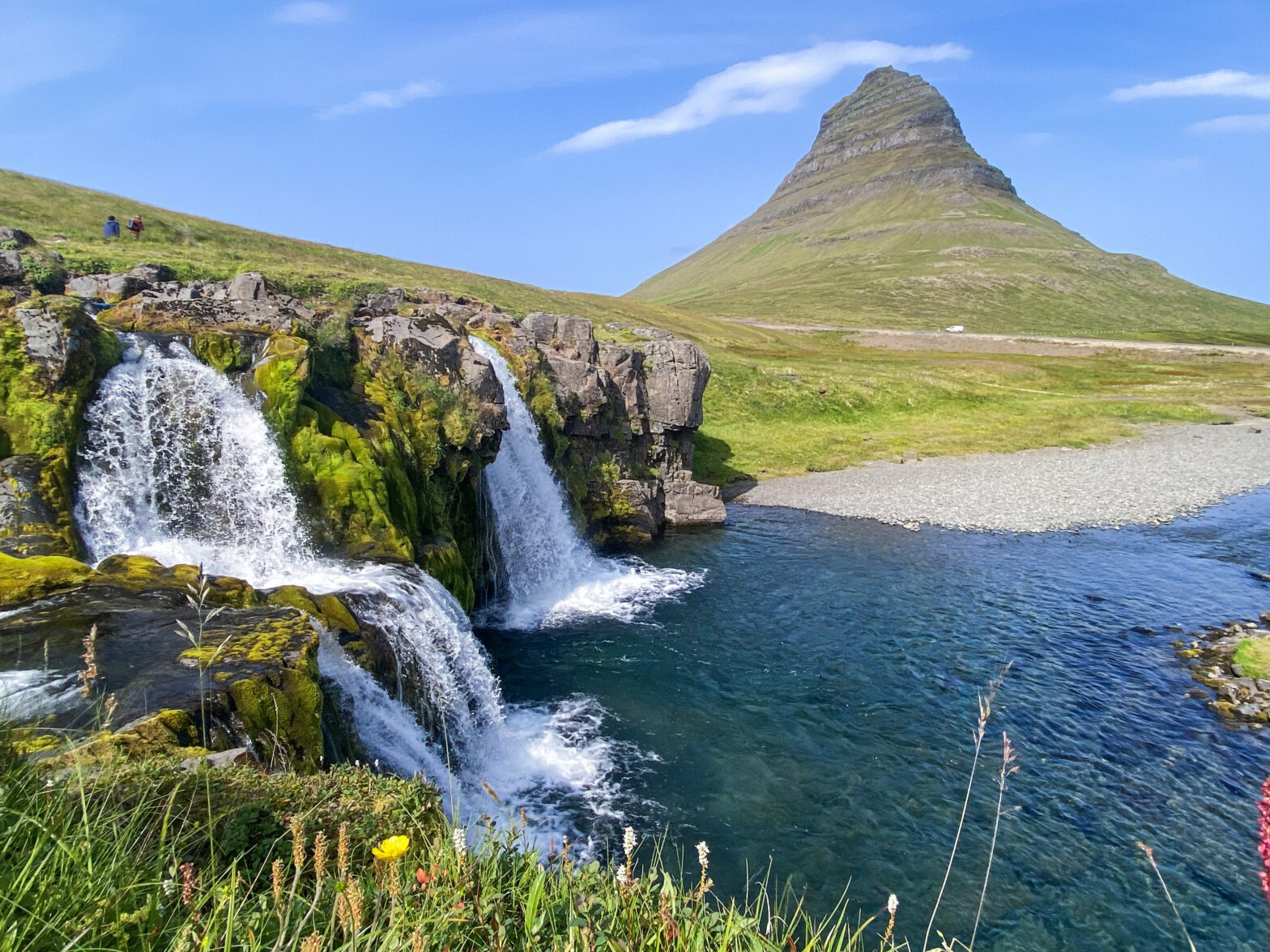In some of my previous blog posts highlighting Elizabeth and my honeymoon adventures, I wrote about the cool things we did on the island. Snorkeling in a tectonic rift, walking through an ice cave, climbing a glacier, bathing at Blue Lagoon – all of those things have something in common. They’re all active. There was a lot of doing on our itinerary and not a lot of seeing – except for the first 48 hours in Iceland. Our trip planner had done a very smart thing in letting us dip our toes in the Icelandic water before we went head first. And the Icelandic experience could be summed up by Snæfellsnes.
Snæfellsnes is a peninsula about two hours north of Reykjavik. Because of its accessibility and because of how much there is to see there, it’s often considered a great vacation spot for those hoping to see a microcosm of Iceland as a whole. There’s a national park, multiple coastal towns, black volcanic rock, waterfalls, and an active glacier-capped volcano. The whole peninsula is rimmed by a road that at least vaguely recalls the idea of the Rim Road of Iceland. So if you have two days to kill, Snæfellsnes makes for a great place to do so. Elizabeth and I stayed two nights in the town of Hellnar at the southwestern tip of the peninsula, right at the looming foot of Snæfellsjökull. In doing so, we had the chance to drive a good chunk of a loop around the peninsula clockwise and stop at all of the sights. I’m not going to do a narrative of the whole drive; that would be like 8,000 words worth. Instead, I’ll just hit the physical highlights and then some of the other factors involved.
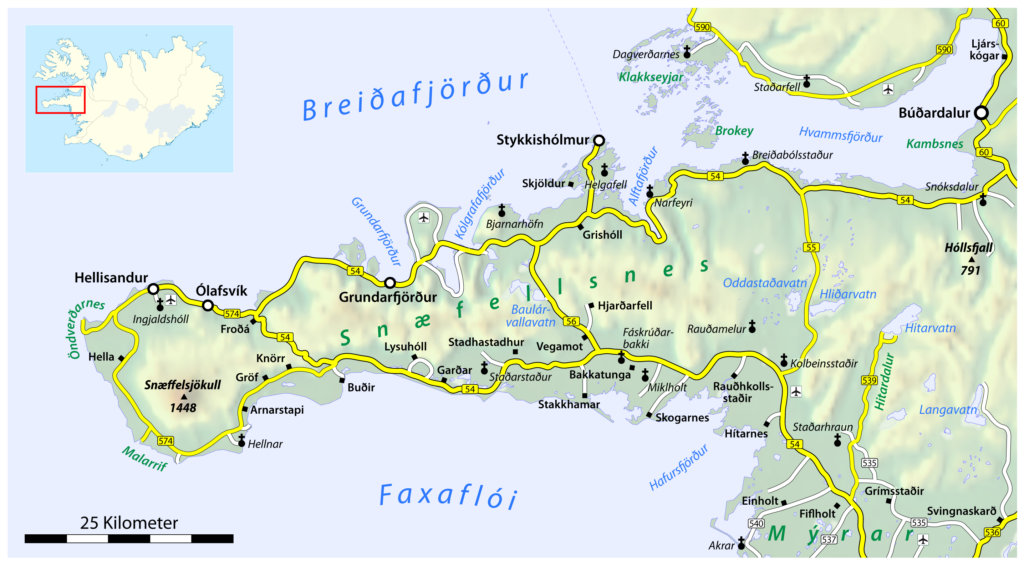
Where We Stayed:
Elizabeth and I stayed at the Fosshotel Hellnar. For me, this was maybe the biggest jolt about how remote Iceland is – when you stay at a small town in the US, there’s a few hundred people. Hellnar has a full-time population of under 10 people these days. I was also a bit jolted (here’s some Nolan naivete) by the hotel. Not that it wasn’t nice – the rooms were clean and the restaurant was phenomenal – but it was far less ornate and posh than I’d expected at the price. Again, I’m dumb. You go to Google and look up “Fosshotel Hellnar” and it shows a 3-star hotel, which is exactly what it felt like. But I was still thrown off. However, there was an insane ocean view from the patio and this view at sunrise the last day:
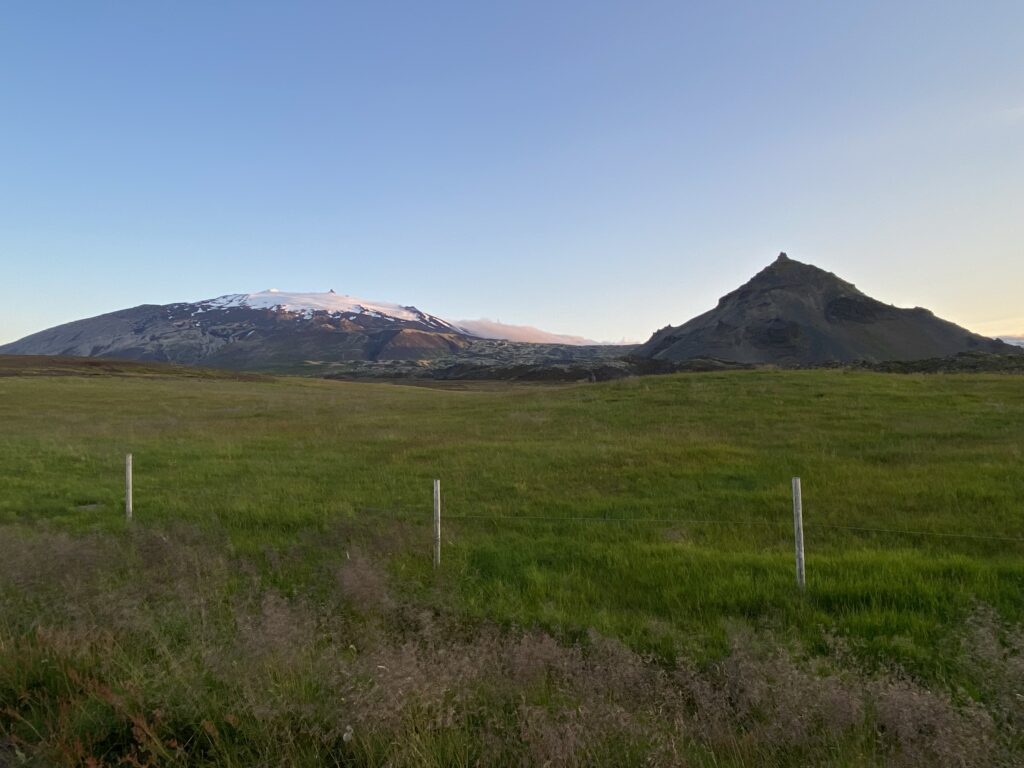
So I’m not complaining. Even more importantly, Elizabeth and I slept like a rock both nights. I can’t overstate how tired we were that first night in Iceland. We dragged through the whole day driving up to Hellnar and refused to sleep until after dinner to jolt ourselves onto Icelandic time. The bed came in clutch under the circumstances.
Where We Ate:
Dining options out on Snæfellsnes can be scarce; even when you find a town, there might only be 100 people and one cafe-type thing. Eating at the Fosshotel was a great decision for multiple reasons; first of all, they had a pretty good restaurant that I cannot believe I didn’t get a single picture of our food from. If I recall, I got the beef tenderloin on our first night staying there and it was a big part of my immediate falling asleep thereafter. The hotel also had breakfasts of what I would call the “typical Icelandic hotel” style. There were lots of breads, meats and prosciuttos, beans, and wafers and cookies that you could dip in the Icelandic yogurt known as skyr. We got very used to eating those over the course of the week.
On July 26, the limited options struck. We were limited to a choice of 1 or 2 options at most in Hellisandur, and ended up following the Rick Steve’s recommendation and visiting Gilbakki Kaffihaus. It was an excellent choice – a home converted into a quaint coffehouse in the middle of town. As far as actual lunch options, they were quite on the slim side, but you could get bread and cold cuts, and you could get Happy Marriage cake, and you could get coffee. So we made do. The Happy Marriage cake appears to have worked so far.

For dinner that night we stopped at Sker, a more upscale, modern-type restaurant in the more bustling town of Olafsvik (population 1,000). I got a salad and was pretty pleased with it, though once again I appear to have failed to take a picture.
Snæfellsjökull:
One of Iceland’s 3 national parks can be found at the far western tip of the Snæfellsnes peninsula: Snæfellsjökull.
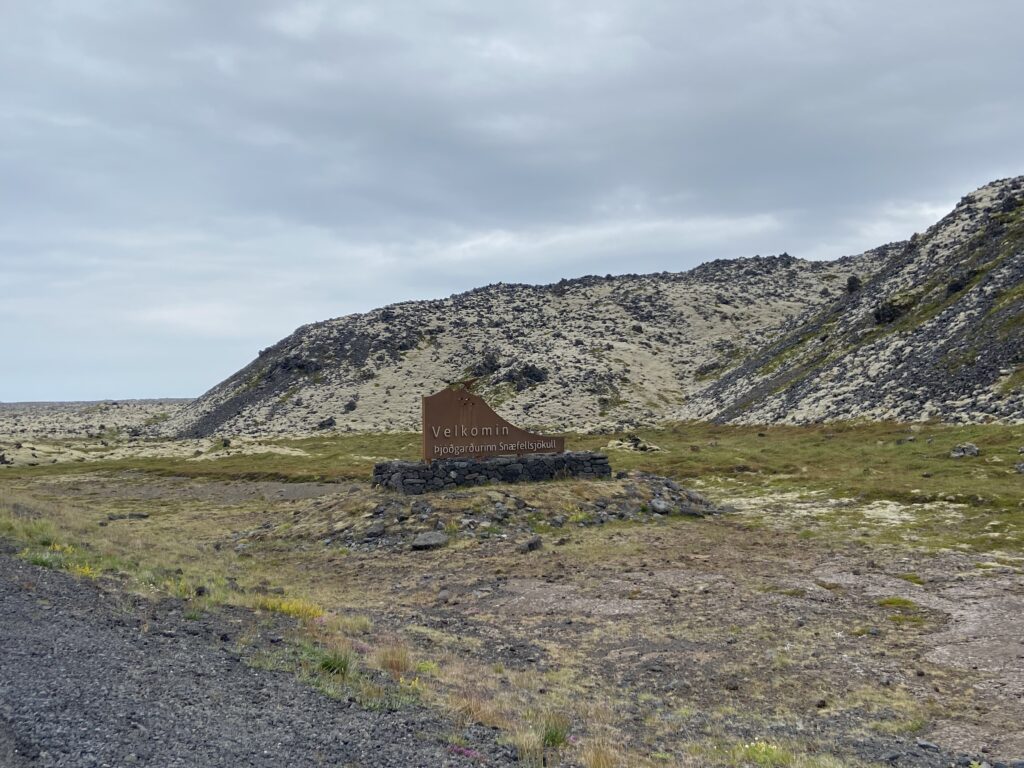
That translates to “Snow Mountain Glacier” in Icelandic – they have a way with words. As the name implies, Snæfellsjökull is an active volcano that rises 4,700 feet above the ocean at the tip of the peninsula, topped by a (fast-retreating) glacier and surrounded by some impressive lavafields. It was impossible to see the mountain on our drive in on July 25 due to Iceland’s ever-present stratus deck. But the cloud level started to rise on July 26, and occasionally the sun broke through entirely to shine upon the mountain. Here it was as viewed from Ingjaldshólskirkja church on the north side:
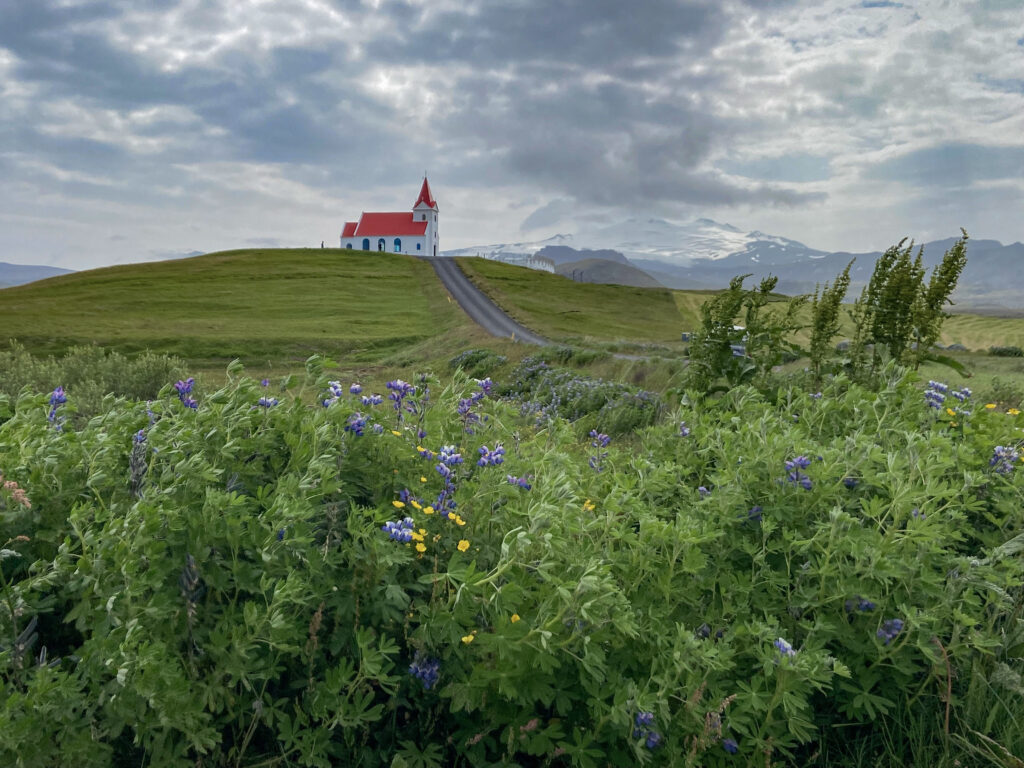
Yeah, it was pretty neat. Running to its east down the spine of the peninsula was a narrow, volcanic range of mountains. That meant that even though Snæfellsnes is 100 km long and sometimes only 10 km wide, it is only pierced by 2 roads, meaning you have to do what we did…
Our Drive:
Alright, everyone stop the presses: We had no plan. Elizabeth and Nolan Meister – a couple who plan every single thing they do on vacation right down to the very last meal – had no outline of what to do with nearly two full days worth of time in Snæfellsnes. This was my doing – I was the Guy At Least Nominally In Charge of the Honeymoon, after all. Part of my reasoning was practical – if you’ll recall, Elizabeth and I had this other thing happening a few days prior that took up all of our available time and energy. Part of it was a genuine desire on my part to live out the adventurous, spontaneous lifestyle. What better way to do it than to drive the loop around Snæfellsnes with no service, no YouTube videos, nothing but the Rick Steves Iceland driving guide and each other to decide what looked cool?
Would I ever do it this way again, having done it once? Maybe. Definitely not with how tired we were though. When you’re switching drivers every 45 minutes to keep from falling asleep at the wheel after a redeye flight, deciding to stop because “Hey, this sounds cool!” isn’t necessarily the way to go – especially when your brand-new wife deals with decision paralysis. With that said, there were some truly cool stops that I was entirely unprepared for, and the surprise was like a little gift-wrapped bundle of fun. But yeah, maybe having a plan on our literal honeymoon was the proper way to go. Here’s a map of how we traveled the peninsula (blue on Tuesday the 25th, red on Wednesday the 26th:
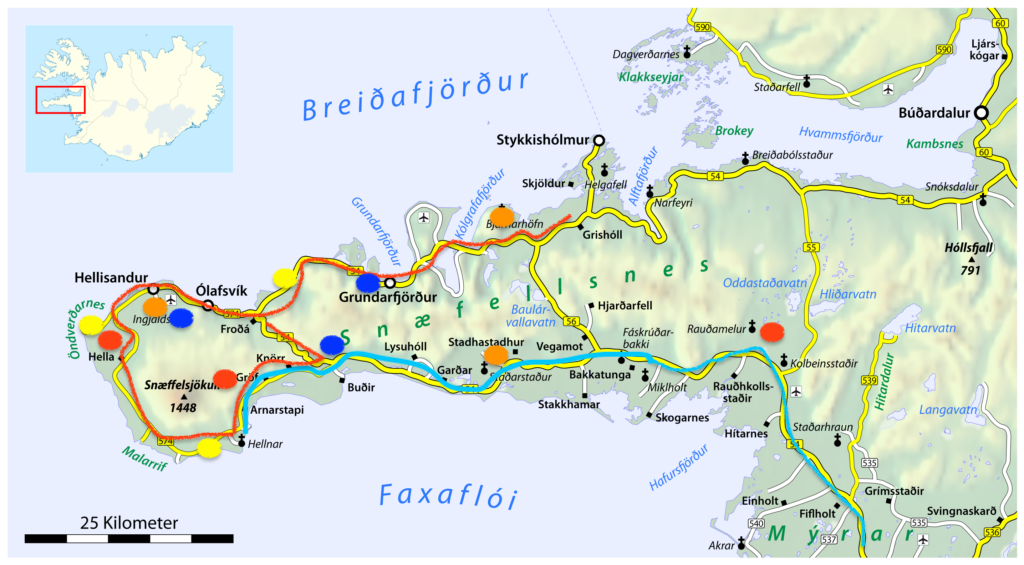
Let’s go over those stops.
Gerðuberg Basalt Cliffs
Our first real stop of the whole honeymoon! Up to now, Elizabeth and I had just been dealing with a stressful night and day of travel (a quick summary: getting bumped from first class on our flight from Denver to Keflavik then getting seated apart on the flight, getting to Keflavik only to realize THIS WASN’T REYKJAVIK and panicking until we purchased bus tickets to the city to be able to rent our car, actually renting the car and stopping for lunch in Reykjavik, then making a 2-hour drive through abject exhaustion that only got longer when a tunnel was closed on the road) and just trying to stay awake and enjoy the scenery. But this was the real start of our adventure – a pull-off onto a dirt road that led to a line of basalt cliffs in a hillside in the distance.
If that doesn’t sound crazy exciting, well, it wasn’t crazy. But it was pretty cool to see. The columns end up nearly perfectly hexagonal.
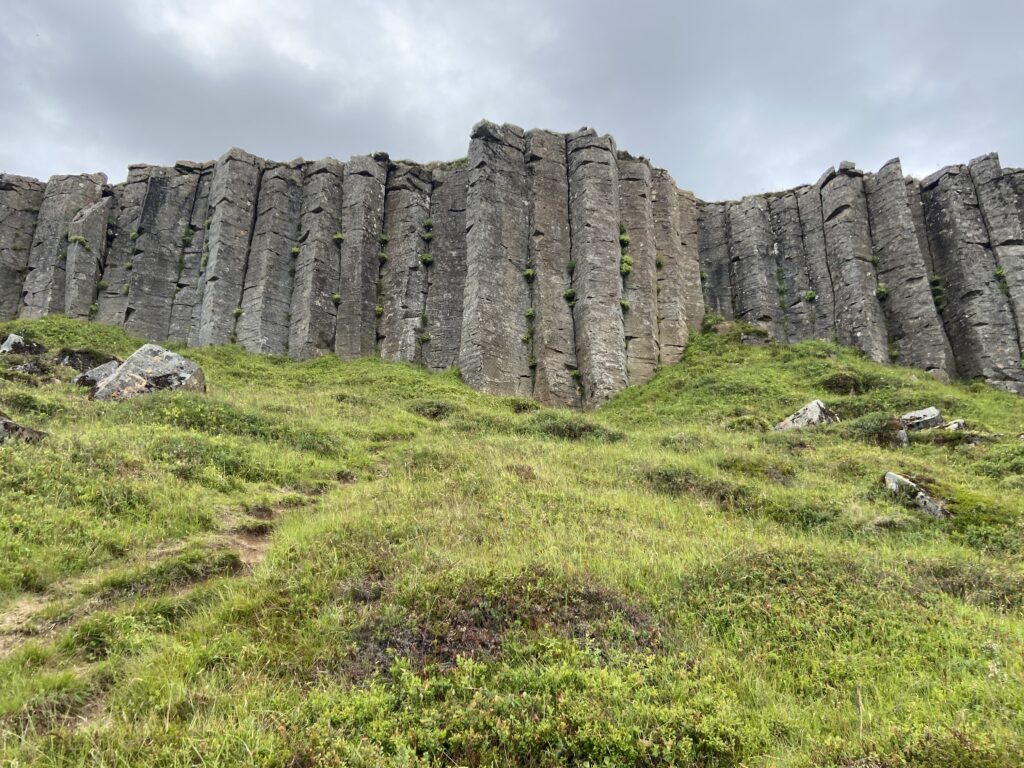
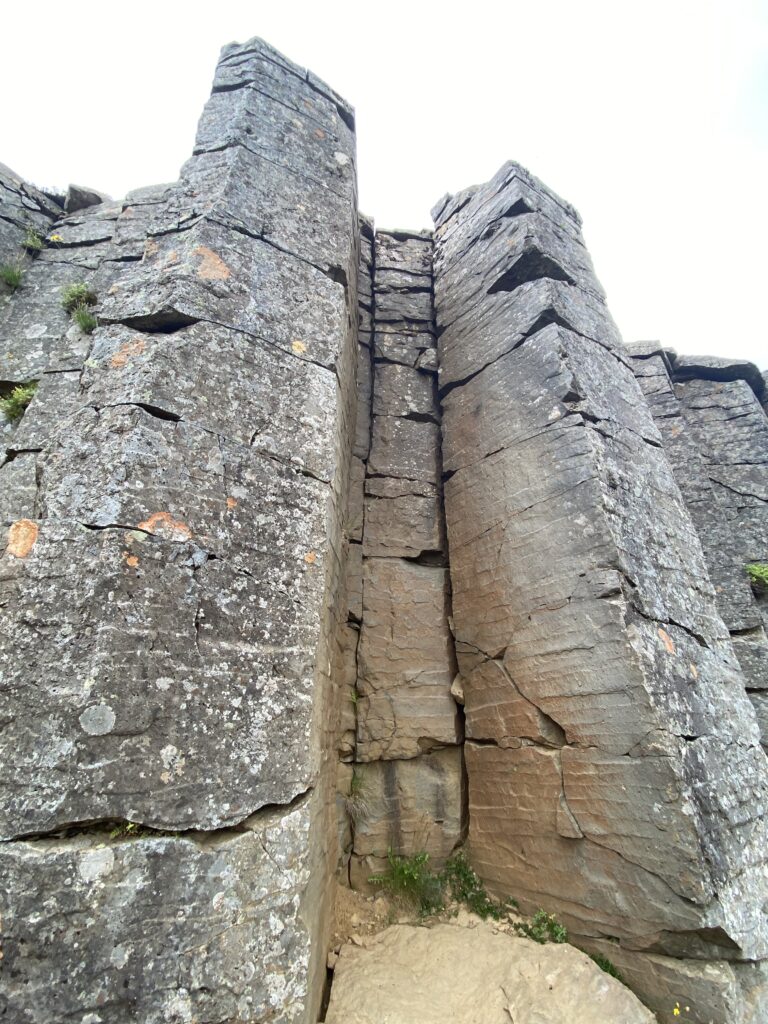
And you can climb up to the top of the cliff.
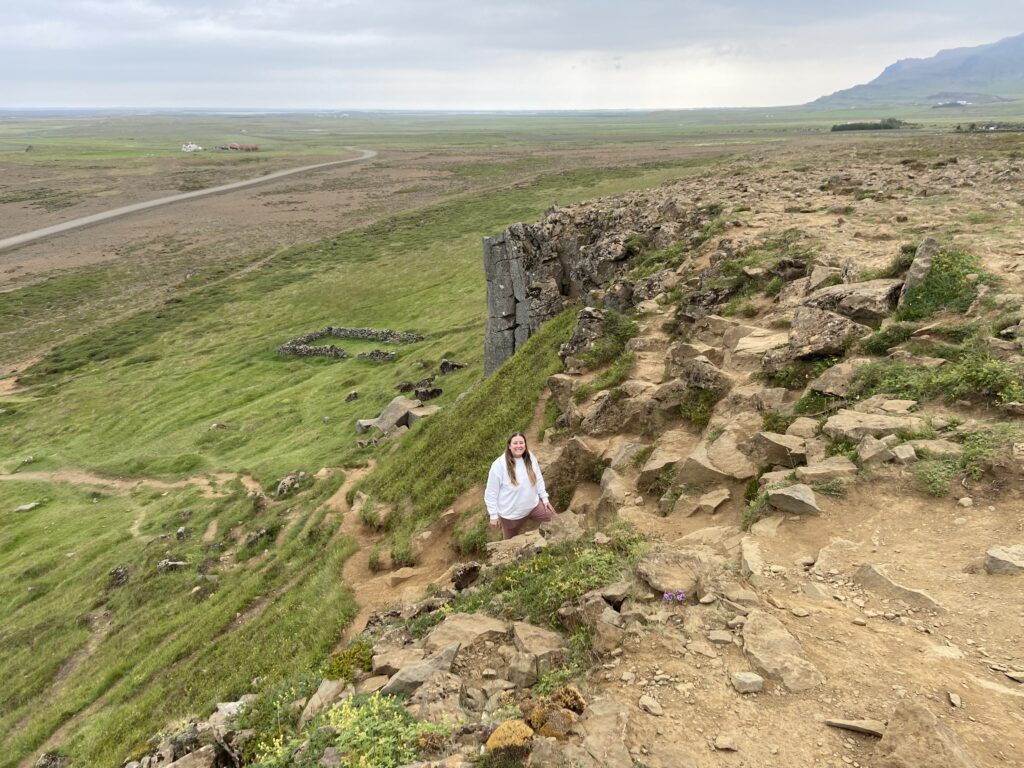
You can even wander back further to a little snowmelt tarn at the foot of a small mountain, and maybe even get a good look at some Icelandic sheep (they’re everywhere – on the roads, in the lava fields, everywhere). It was a neat introduction to the most geologically unique place we’d ever been.
Olkelda
This is a true measure of how desperately tired we were – Elizabeth and I plotted a stop just 25 minutes away from the Gerduberg Cliffs to make sure we had a manageable drive time without falling asleep. Olkelda basically means something like “ale spring” in Icelandic, which is apt – it’s a spring on someone’s property where the water comes out carbonated. Like, legitimately. We tapped a little bit of the water and it tasted like Coke without the flavoring. I love that this spring was here – it’s like a Route 66 thing in America, but unlike Route 66 there is absolutely zero attempt to capitalize on tourists. It literally just sits on someone’s farm.
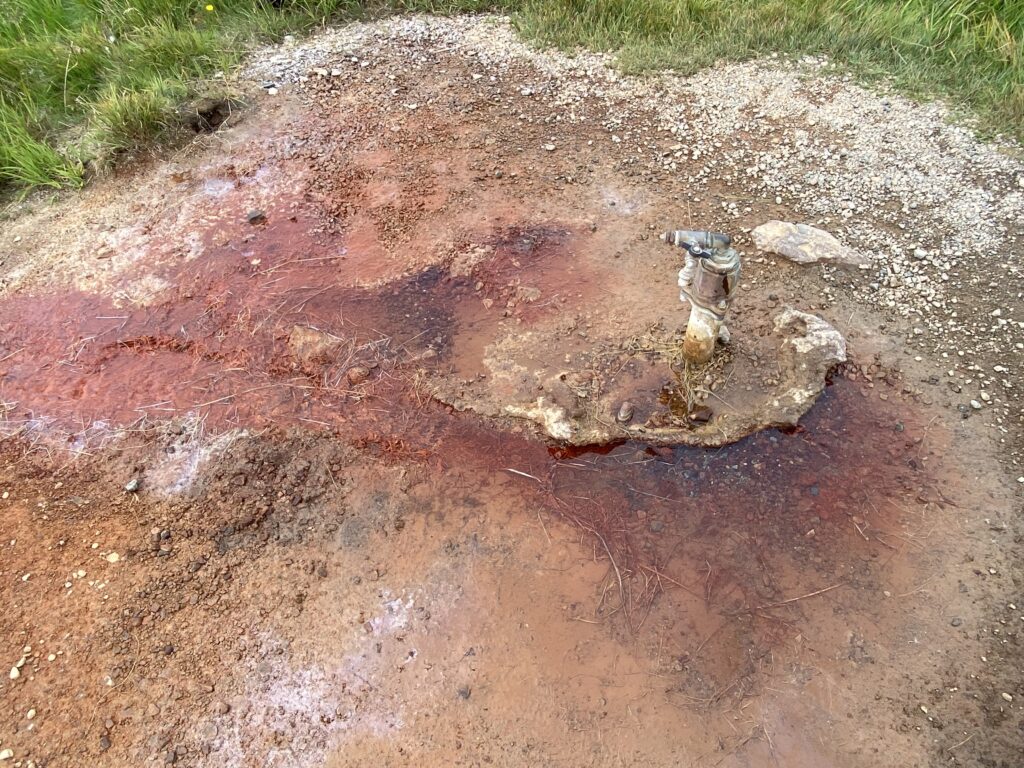

Bjarnarfoss
Our first legit Icelandic waterfall! Now I say this loosely, because it turns out that Iceland is full of little-known, little-named waterfalls just tumbling off of cliffs. I’m serious. In the couple dozen miles it takes to get across the south side of Snæfellsnes, you see a bunch of them. But Bjarnarfoss takes a bit more fame than its neighbors thanks to its two-tiered fall through basalt columns. There’s a little parking lot and then you walk a hundred meters or so to get to the base of the fall.
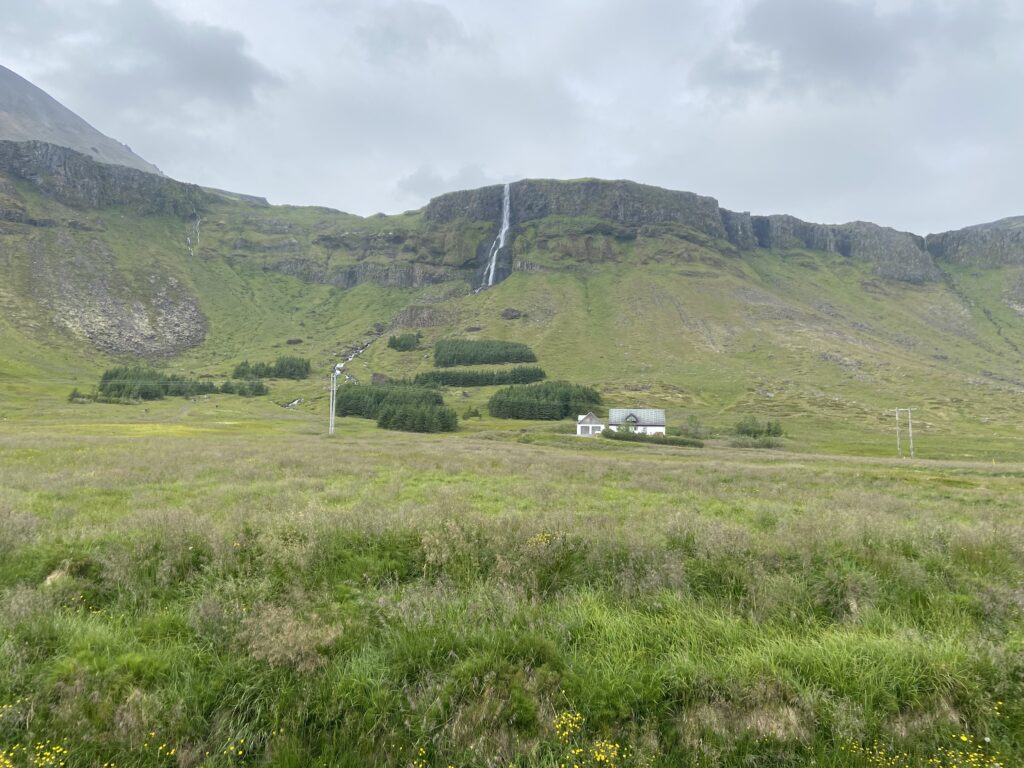
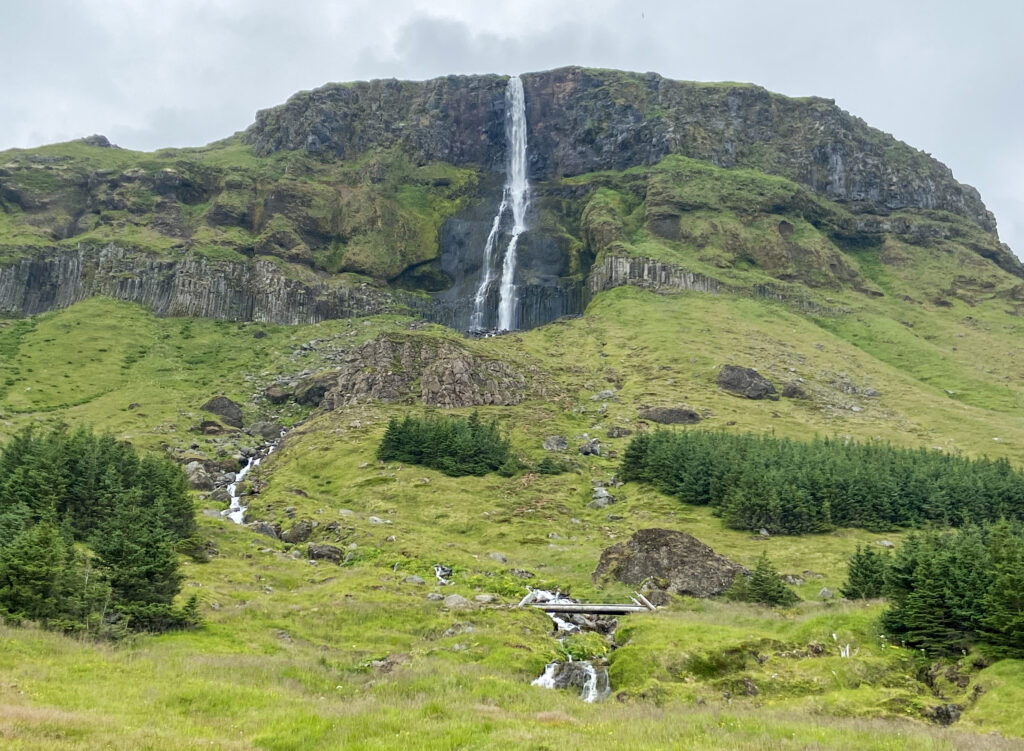
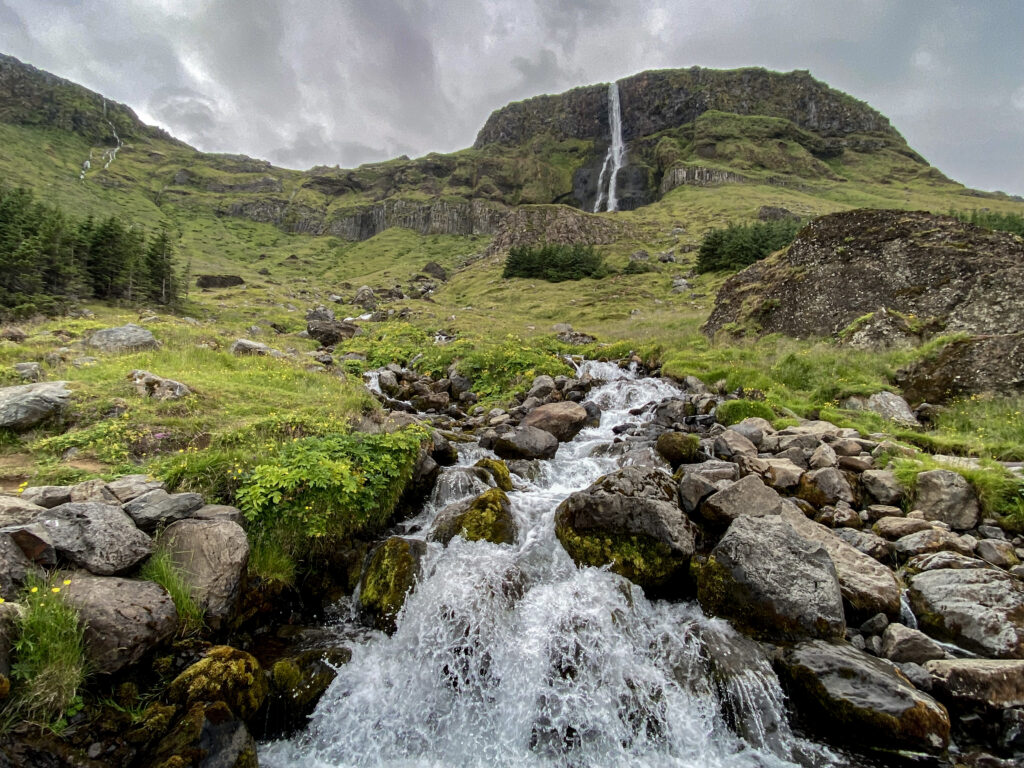
It was just so quiet, too. That’s the thing I was quickly adjusting to. I live in Oklahoma and chase the Great Plains. I’m used to wide-open, empty spaces. But those generally occur under a huge, blue sky. This felt more like stepping back to the time before man.
Rauðfeldsgjá Gorge
Our last stop on the 25th – tantalizingly close to Hellnar and our hotel – was at this gorge. It kind of was similar to Bjarnarfoss in that somebody had basically just thrown a little driveway off the main highway with a parking lot, and there was absolutely no other sign of civilization around. This attraction was a narrow gorge in the side of a mountain from which a creek tumbled its last couple hundred meters into the ocean. It’s mind-boggling to stop and comprehend that all of this stuff happens in such close proximity to other attractions and the ocean and easily-accessible roads.
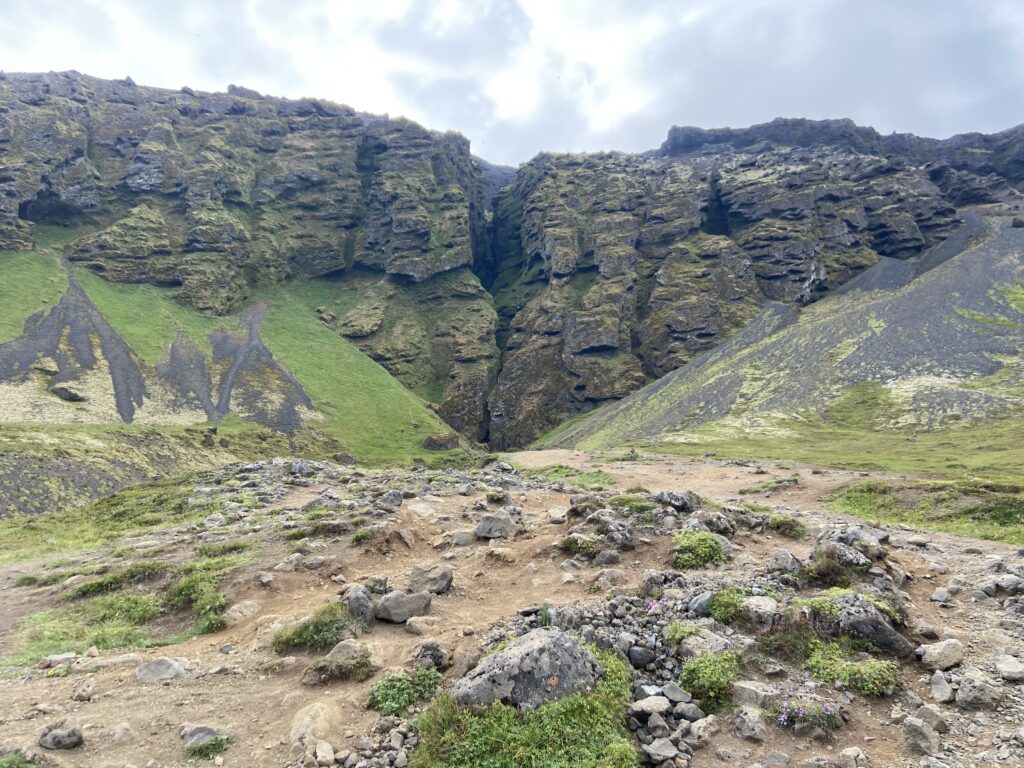
You walk basically up the right (east) bank of the creek until you reach the gorge. Then, with a few slippery steps around the corner, you can walk right in. The bad news is my photos from the inside of the gorge were over-exposed and generally sucked. The good news is that Elizabeth has us covered. The bad news is her pun.
Lóndrangar
On July 26, Elizabeth and I had nothing planned but a drive up and around the western and northern side of the peninsula. Our first few stops were at the very foot of Snæfellsjökull – first, a monument to one of the wives of a Viking explorer who found Iceland:
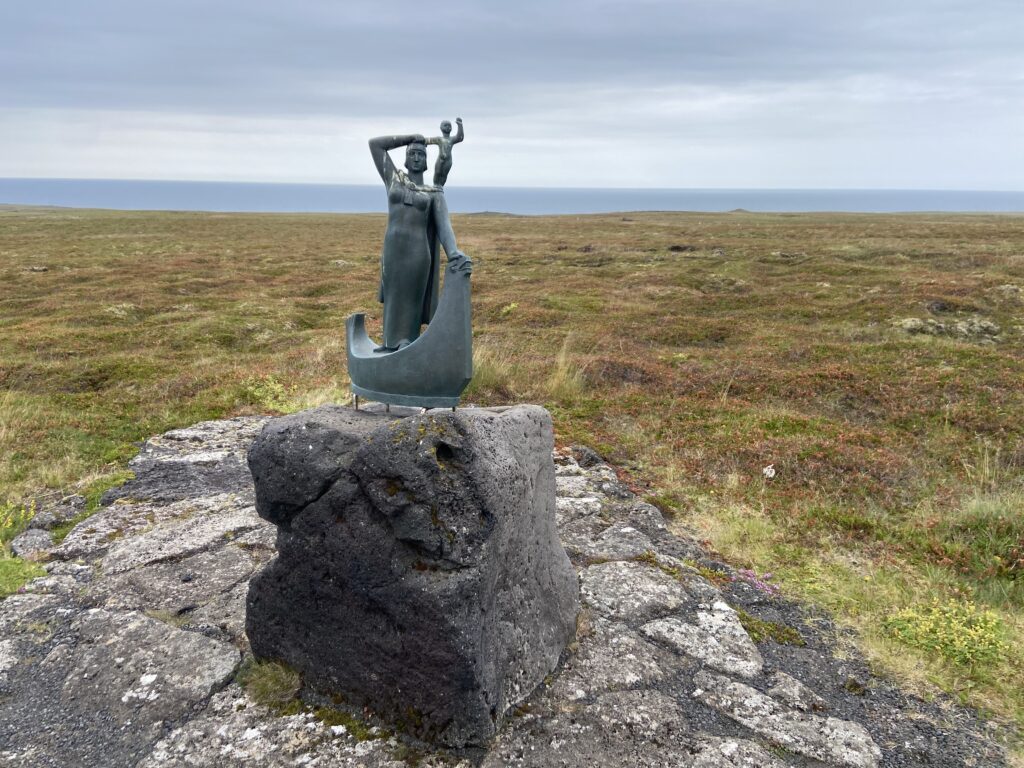
And then the famed basalt cliffs at Lóndrangar on the coast. The cliffs were a startling black against the churning grey waters of the Arctic Ocean. Where most of Snæfellsnes impressed with how quiet it was, the cliffs here were loud: there were thousands of birds in constant motion among the cliffs. No puffins, though.
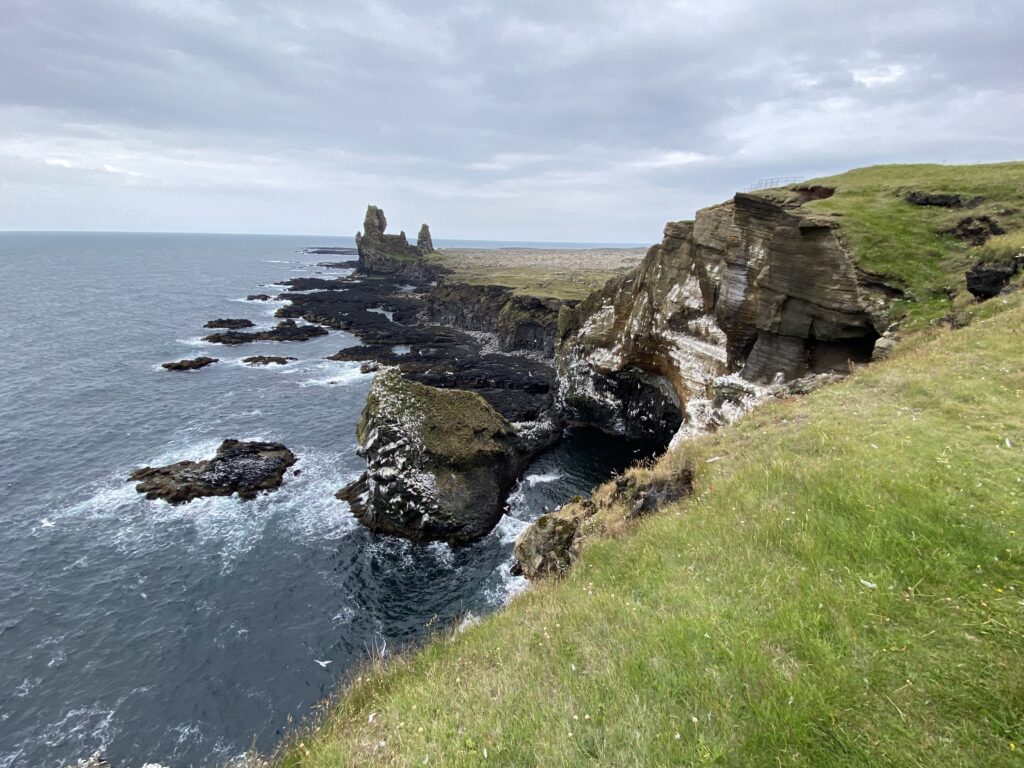
There was even a little visitor’s center for Snæfellsjökull National Park. It was tiny and just staffed by one person, but there was plenty of educational material, which I always appreciate in a visitor’s center.
Djúpalónssandur
(This is located just southwest of Snæfellsjökull and absolutely should have been on my map, but I left it off and I’m not going back to fix it. Shut up, this is my blog.) Djúpalónssandur, a word I can totally pronounce, is a black-sand (really black-pebble) beach at the edge of a relatively young lavafield.

There’s a lot to unpack in this spot – the little lagoons at the edge of the beach where local lore has it that a strong swimmer once managed to get to the bottom of the lagoon and popped out in the ocean –
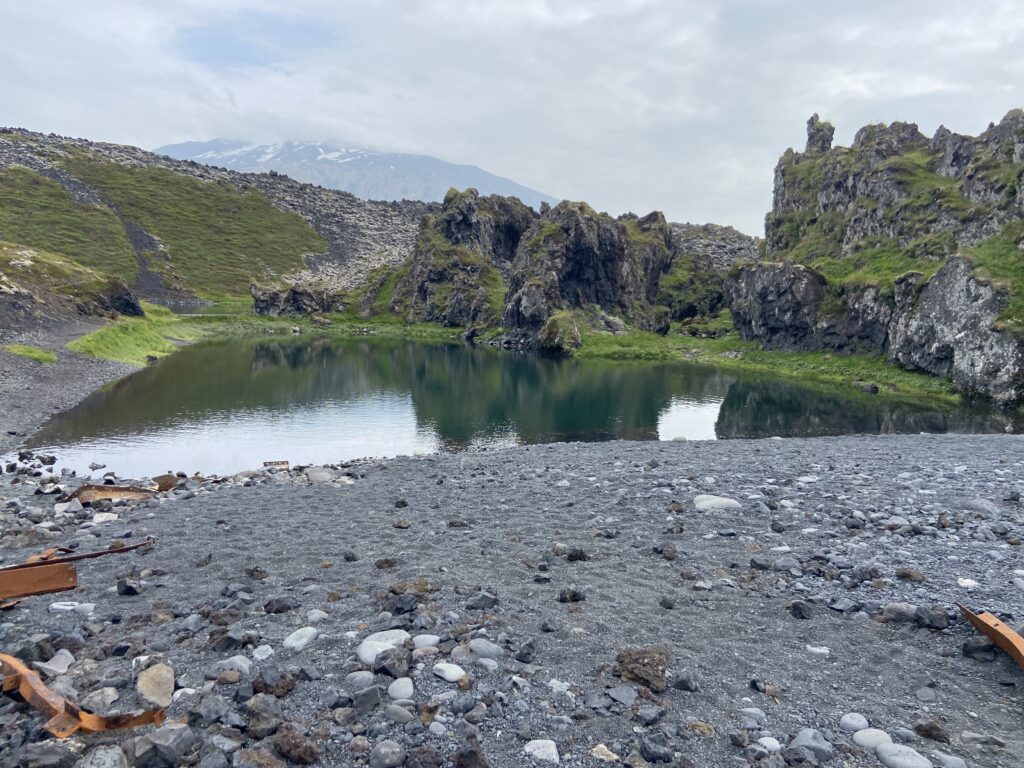
The shipwreck of a British fishing boat from the 1940s:
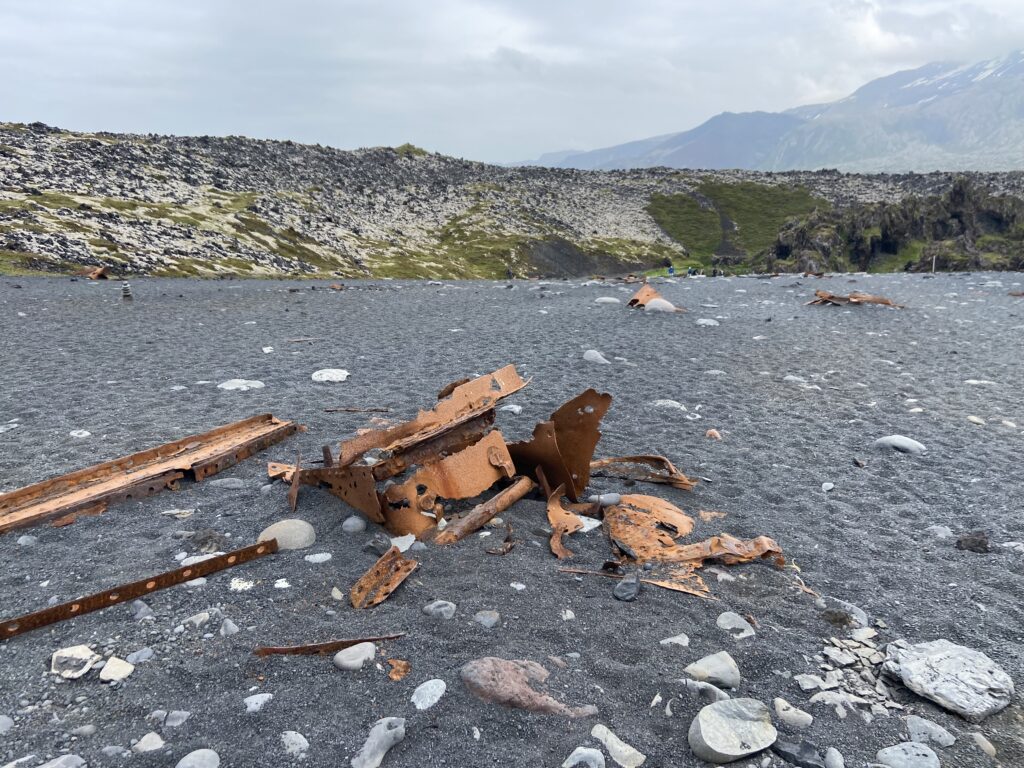
But for me, the highlight was walking right down to the water and listening to the waves crashing through the volcanic pebbles. It made an oddly musical sound that I can’t quite describe – sort of like listening to thousands of maracas all at once, but more pleasant than that. Months later in Oregon, Elizabeth and I visited a black sand beach with my parents. I told them to join me at the edge of the water and we listened to it again. On a cold, windy, rainy kind of day in Newport, I felt transported back to Djúpalónssandur briefly.
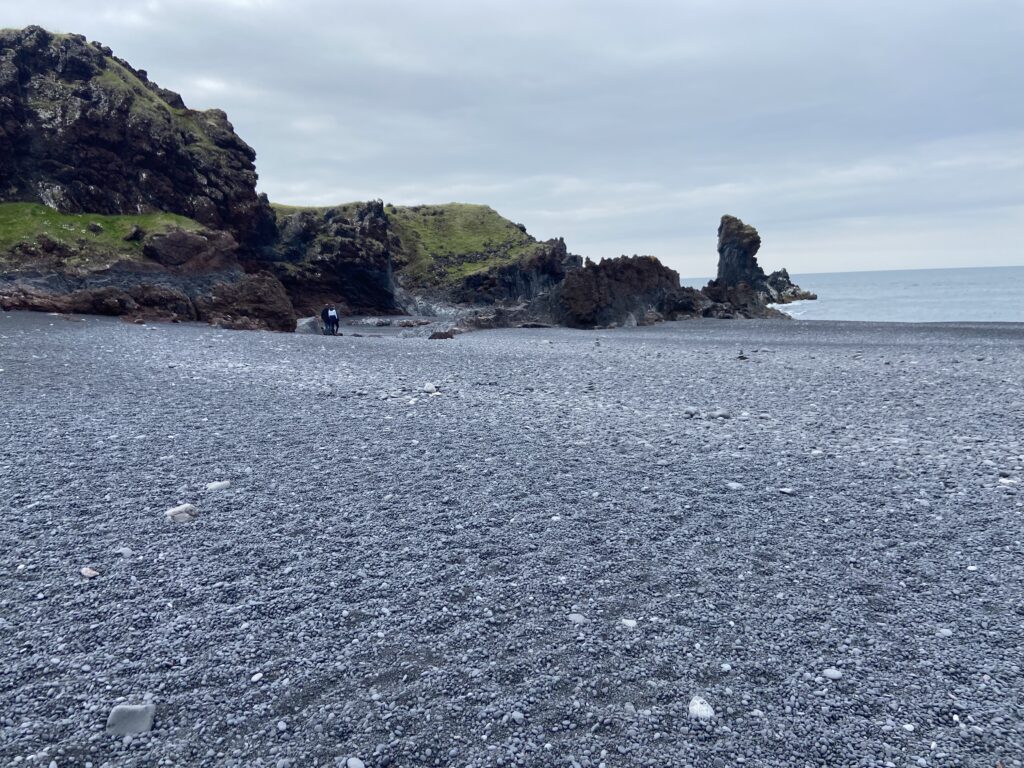
Saxhóll Crater
A good chunk of Iceland is volcanic terrain. Most of Snæfellsnes and especially Snæfellsjökull is an active volcano. But on top of active volcanoes and dormant volcanoes and volcanic lava beds, the remnants of old eruptions also dot the landscape. One of those remnants lies on the northwestern corner of Snæfellsnes – the Saxhóll Crater. It rises about 350 feet above sea level, and you climb almost all of those feet along an orange-colored staircase that winds around the cone-shaped volcano.
The climb was… windy. Very windy. The staircase was wide, but I hugged the inside of it because I didn’t want to get blown away. It took maybe 5 minutes or so to reach the top of the volcano. The crater inside was ok, but I wasn’t amazed. Maybe it just paled in comparison to the good old-fashioned Capulin Volcano in the good old US of A.
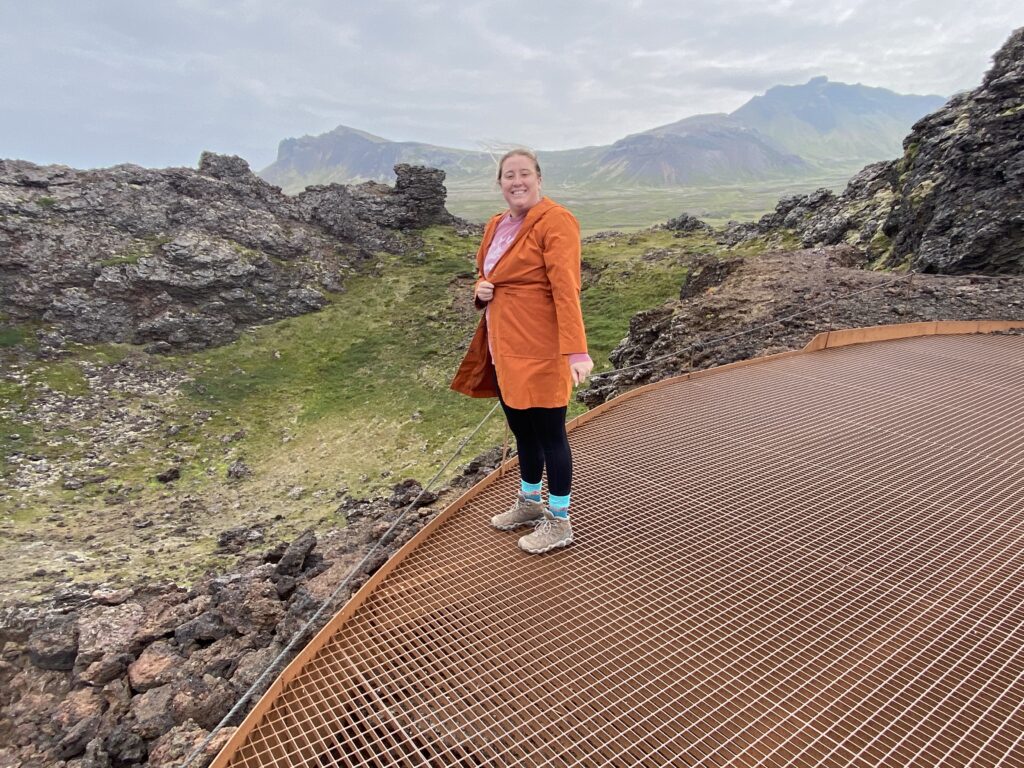
Elizabeth and I got our pictures taken by a group of young German tourists who we kept running into throughout the rest of the day. It’s pretty common in Iceland to run into either continental/British Europeans (the majority of tourists and maybe even the majority of people) or Americans (a loud, vocal minority). On the way back down from Saxhóll, I was struck by how rugged this portion of the peninsula was – lots of jutting lava rock all over the ground. Absurdly, I thought about how good of a paintball map it would make (I don’t play paintball).
Skarðsvík
It’s already been a theme in a lot of my location summaries – the famed black lava rock of Iceland. Well, does it come as a surprise then that Icelanders think a yellow-sand beach is an exotic location? That’s really all Skarðsvík was – a lonely road leading to a lonely beach.
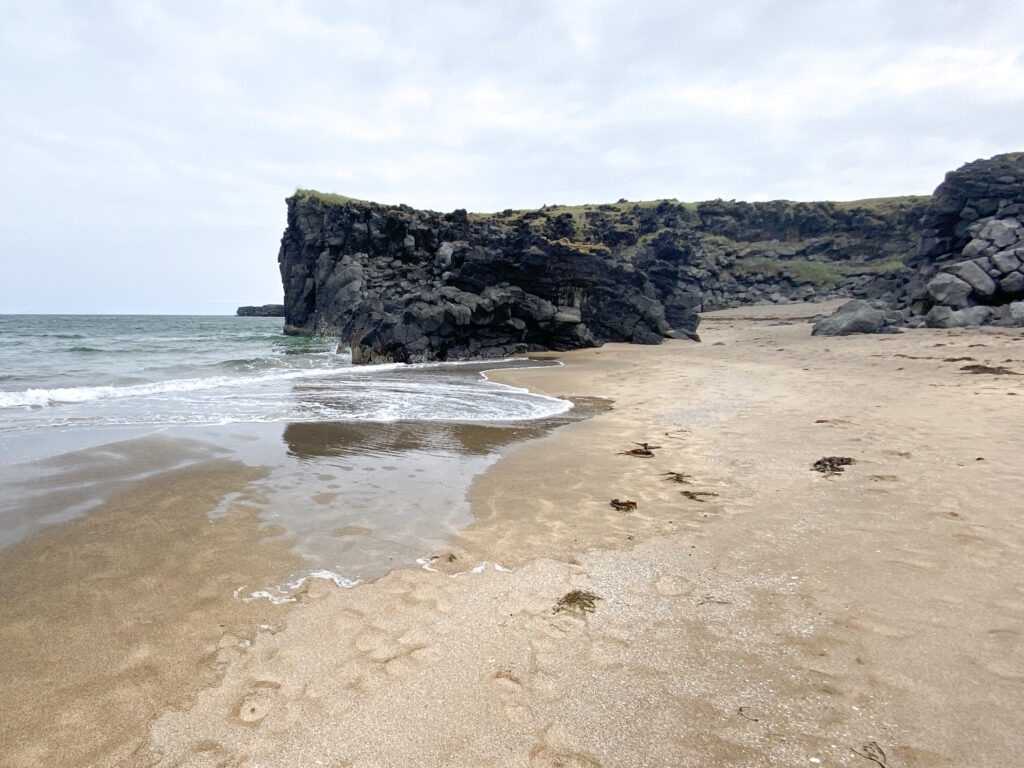
Signs proclaimed that on sunny days, hardy locals like to come out here to see the Mediterranean-blue colored waters and sunbathe. But the two nearby towns of Hellisandur and Rif have a combined 600 people, so I wouldn’t read too much into that. Plus, with how gloomy the morning was (and please don’t think this Oklahoman was complaining about a cool and gloomy morning in late July), the North Atlantic was more of a boiling slate-gray than blue-green. But still, it felt weirdly like a spot of home among an alien planet to stand on actual soft yellow sand briefly.
Ingjaldshólskirkja
Elizabeth and I visited this aforementioned church (previously shown above) shortly after eating lunch in Hellisandur. The sun was just starting to poke out when we made the long, lonely drive up to it. The church sits up on a bluff overlooking a wide, grassy plain. One of the most peaceful-looking cemeteries I’d ever seen sat on the backside of the church.
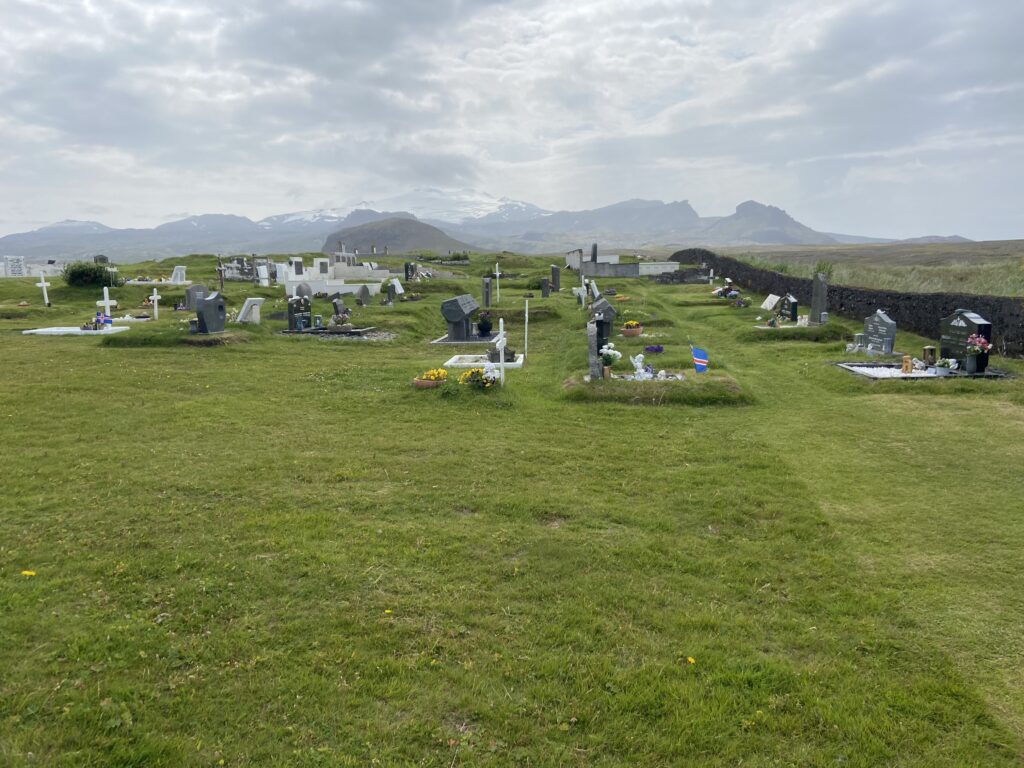
But the view from the frontside bears repeating.

Who knows how many people attend services there, or what type they are. If that’s not the type of view to get you into a spiritual mood, nothing will work for you.
Svöðufoss
This was maybe Rick Steves’ clutchest recommendation of the entire trip. All of the Snæfellsnes videos we’d seen on YouTube somehow failed to mention this waterfall, which in my opinion was one of the coolest ones we saw in all of Iceland. Like a lot of Iceland’s waterfalls, you could actually see it from the main road, and a dirt road led past it (and some ponies) to the waterfall parking area.
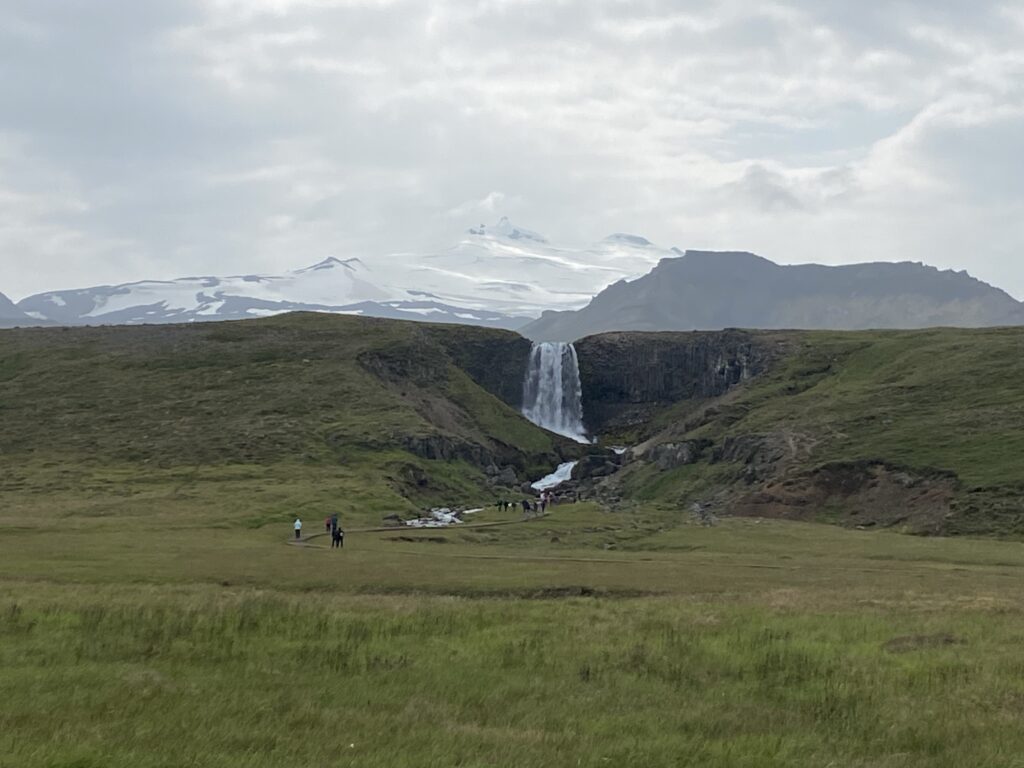
The path followed alongside the stream which was bubbling with fresh melt straight from the glacier.
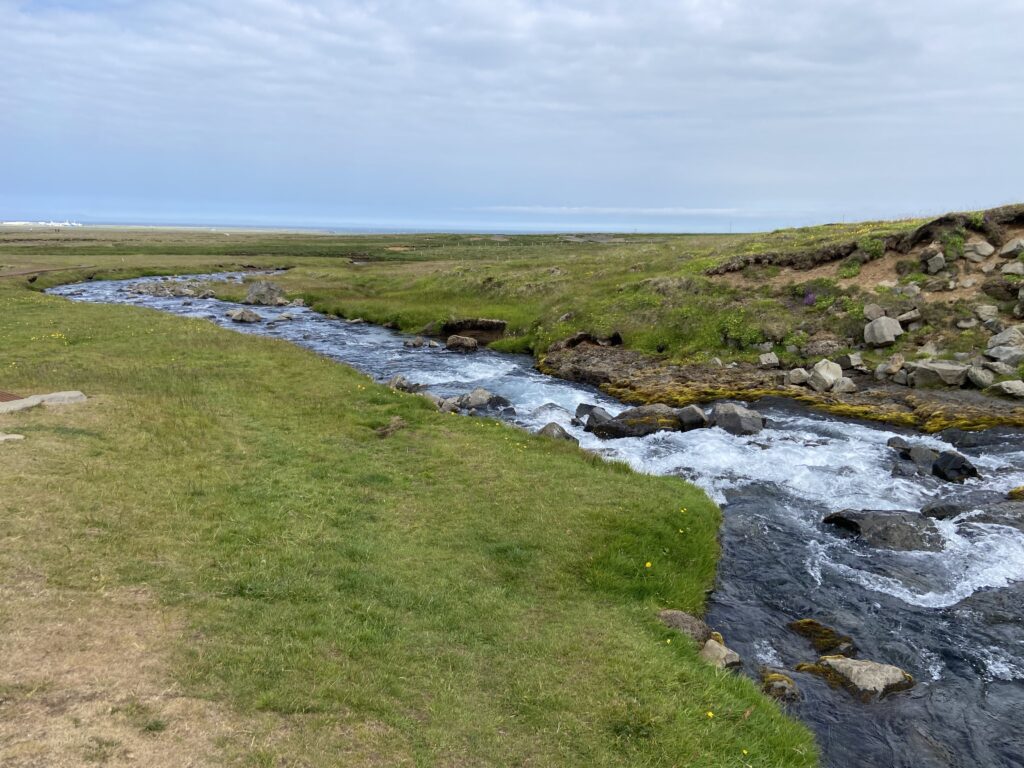
The waterfall was really pretty, too. What are we doing by not advertising this thing heavier?
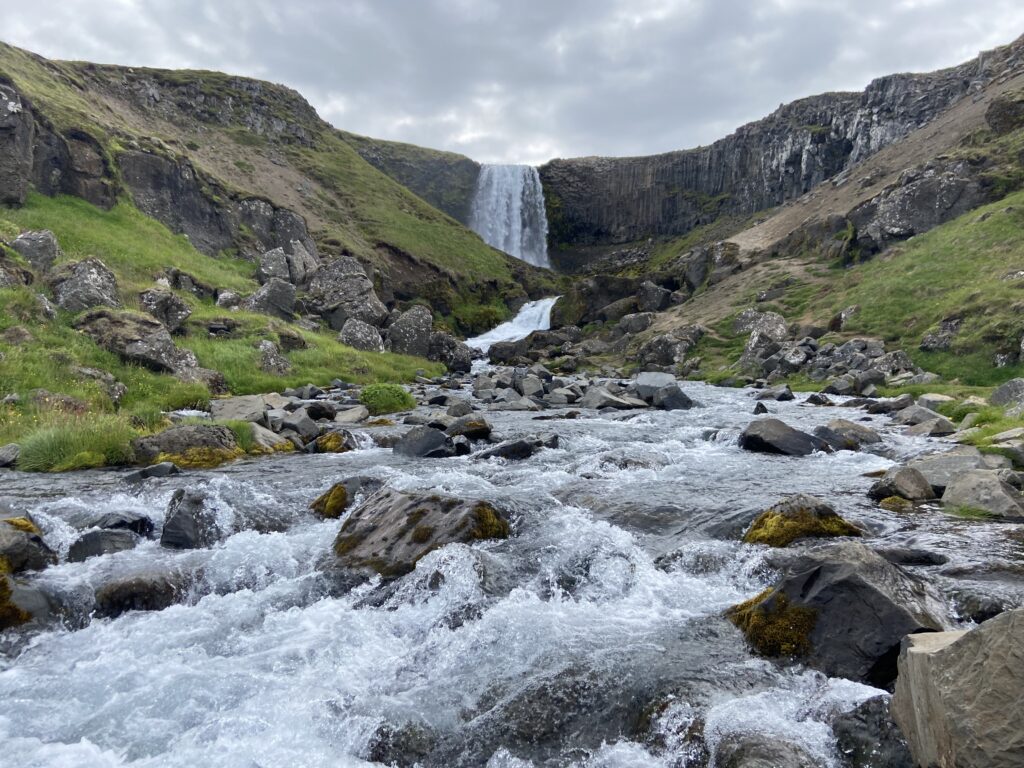
Now if you’re like me, you’re probably wondering if you can get closer to the actual waterfall. The answer is yes. There’s a little path up the right bank that leads to that sort of bare sandy area. Elizabeth didn’t want to check it out, but didn’t entirely say no to me going up there. So I made my way over there – only to discover that the high line that I was taking across the sandy stretch was horrible. There was no traction and the angle was too steep, and I found myself three steps from the end and pinned down with a hand in the ground to prevent myself from sliding off the rock entirely and taking a tumble. After taking a few seconds to assess my options, I let go and lunged forward so that I could slide down and stick my hand into a stone before the drop-off – and made it with a few inches to spare. Elizabeth told me later on that she couldn’t watch as I went through this adventure.
But it was worth it to get this picture amid the cool waterfall mist.

And I didn’t even have to fall into a waterfall and ruin our honeymoon for it.
Búlandshöfði
Past the next town up, Olafsvik, the northern side of Snæfellsnes opens up into a series of wide fjords and jutting peninsulas. The first of this peninsulas is Búlandshöfði, a mountain that basically abuts out into the North Atlantic. The main road is cut into the side of the mountain, which gives a pretty neat view with some prominence. The sun came out at just the right time for this viewpoint after our gloomy morning.
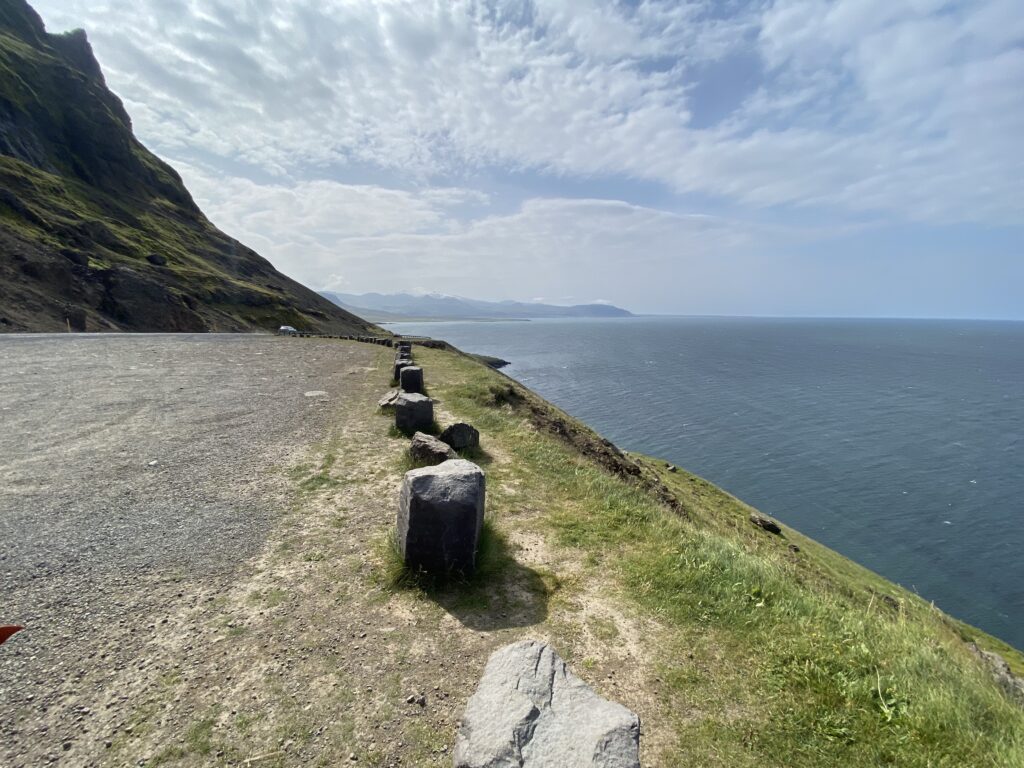
Just a silly thing to get excited about, but that’s the highest-latitude ocean I’ve ever seen.
Kirkjufell
A couple of peninsulas away sits one of the most iconic views in all of Iceland – Kirkjufell. So beautiful that it was filmed in Game of Thrones, Kirkjufell is a narrow, cone-shaped mountain that can be viewed from a waterfall no more than a mile or so away so that you achieve the ultimate Iceland Giga Moment. At least that’s what every video, picture, and pamphlet of Iceland had shown. When you approach from the northwest, you realize that rather being a narrow little traffic cone, Kirkjufell is actually a long glacial arrete that just looks narrow when looked at head-on. I’d seen the same sort of thing in Glacier National Park, but it was still so jarring that I refused to believe it was the right mountain long after being proven otherwise by Elizabeth.
The parking lot for Kirkjufell is right across the road from the mountain. Unlike many of the other stops we’d made along the way, this was actually a major tourist draw, and the crowds of little piggies showed it. So did the parking lot itself, which was our first experience with the charming Icelandic tradition of photographing your license plate to make sure that you pay the parking fee. Given the constant flow of people in and out of the lot, Elizabeth and I didn’t have to wait long for parking. From there, a short path leads 100-200 yards through a beautiful valley posted up at the foot of some snowy mountains:
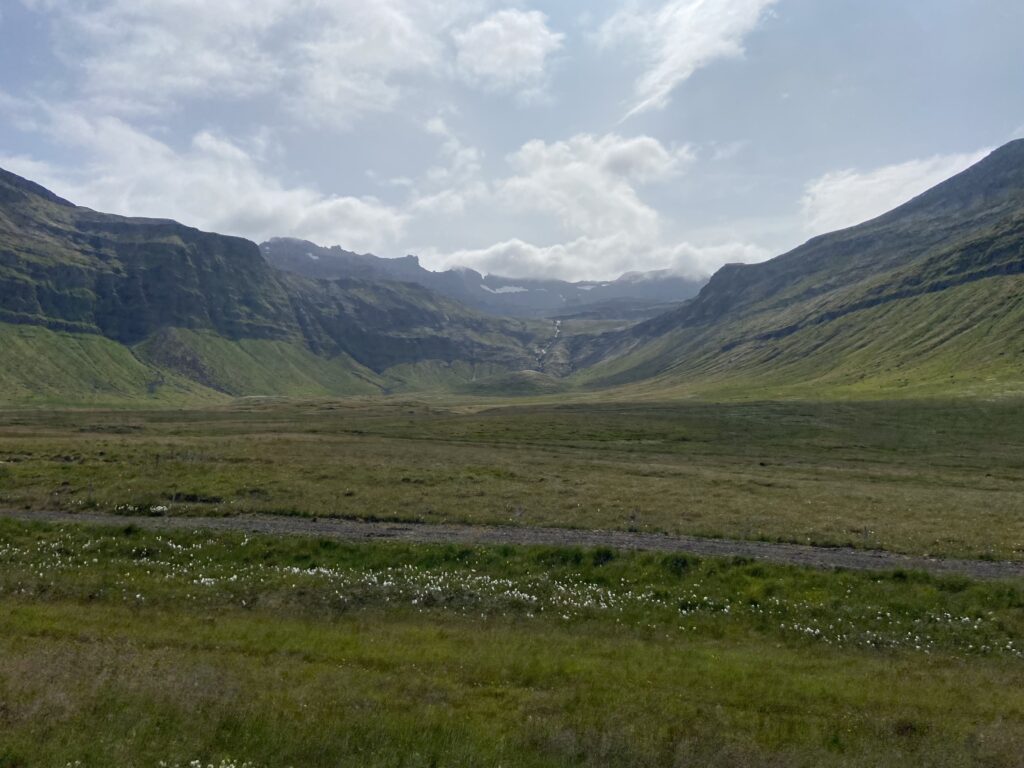
And that path leads you to one of Iceland’s most iconic scenes: Kirkjufellsfoss, or literally “Church Mountain Waterfall”. They believe in simple names in Iceland. It’s a pretty waterfall:
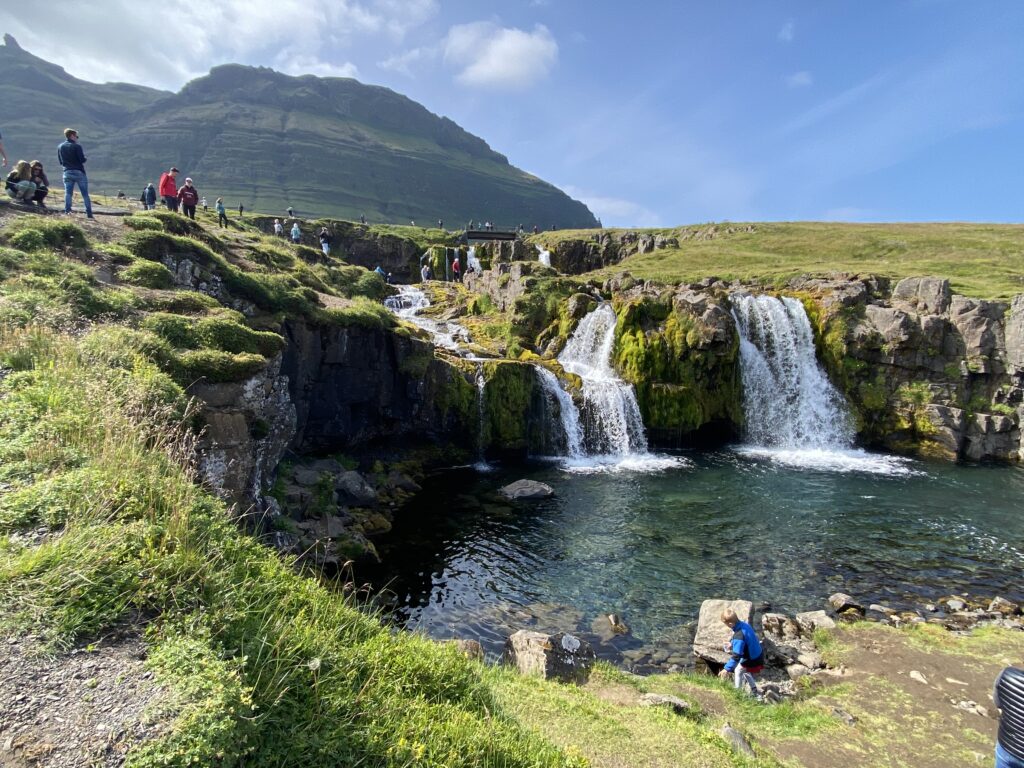
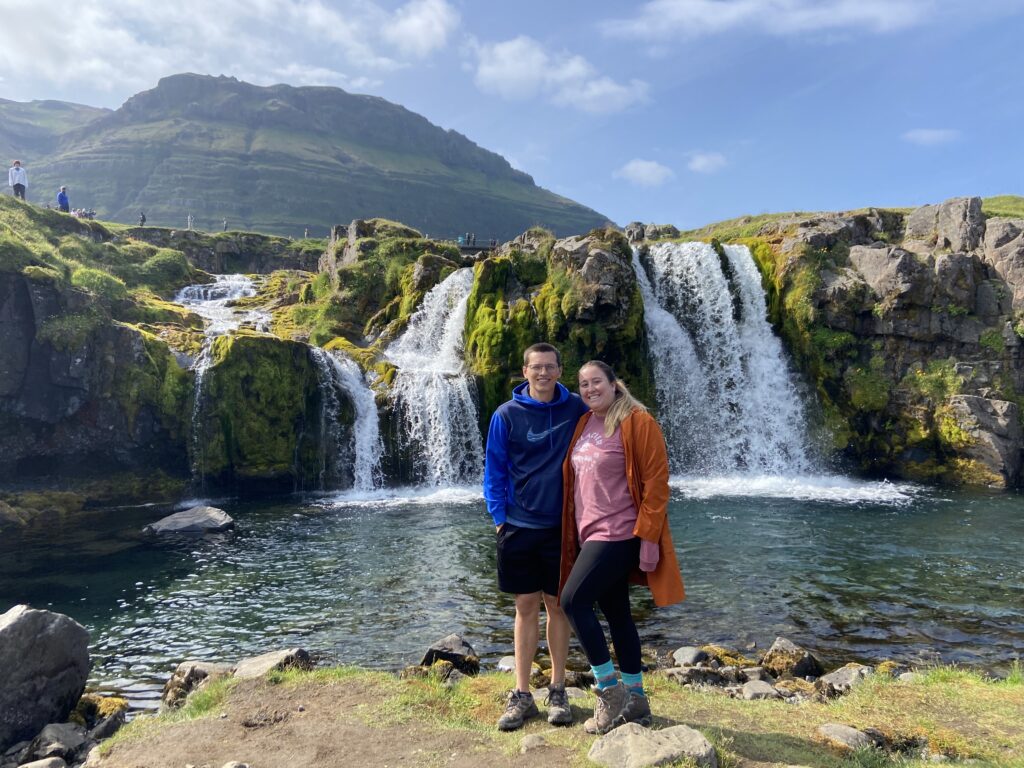
But the real draw of this spot is the look back toward Kirkjufell, which is shaped in that iconic spire look from near the waterfall.
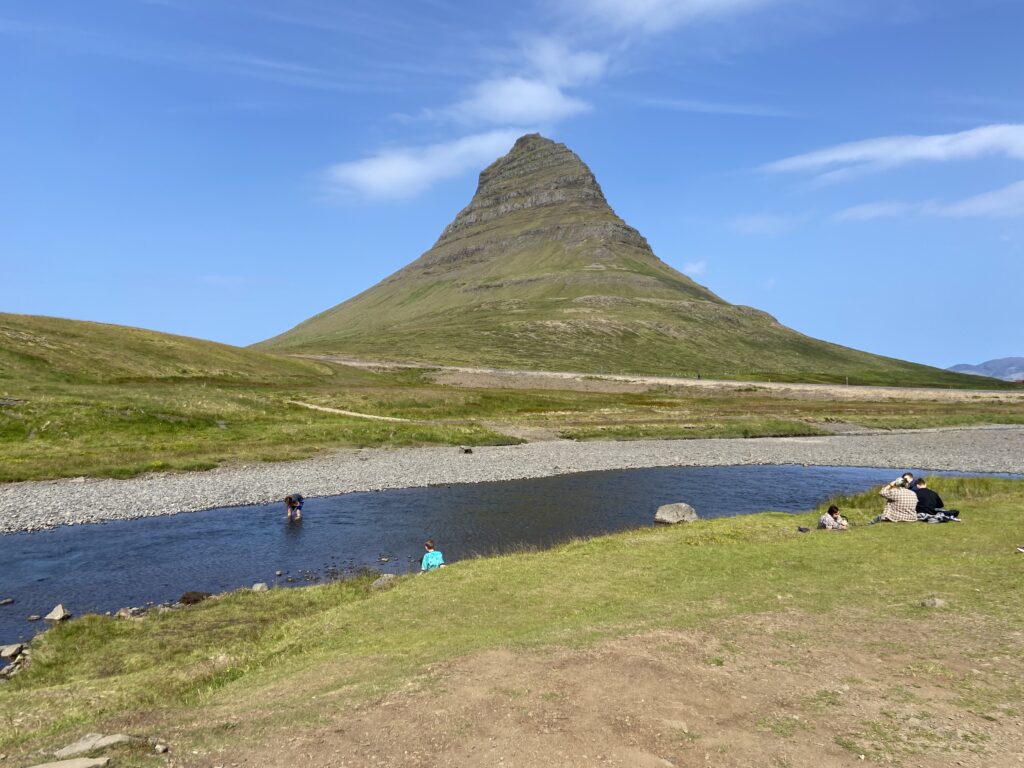
Absolutely great time for the sun to fully come out, by the way.
Elizabeth and I took the chance to take a break from our day-long drive around Snæfellsnes (we’d already been sightseeing for 5 hours by this point) and sit on the scrubby tundra grass under a relatively mild midday sun. It was almost warm enough to be comfortable in shorts – and on a day when Oklahoma City “only” reached 98 degrees, no less. After laying there and enjoying the buzz and chatter of dozens of tourists for a few minutes, I regretfully stood up. The little walkway on the far side of the waterfall was roped off, but the ropes were knocked over and trampled. People were wandering all over the waterfall, and I thought to myself: Well, what’s one more? And thus, I got one of the most iconic Icelandic images on my own iPhone (stupid camera battery):
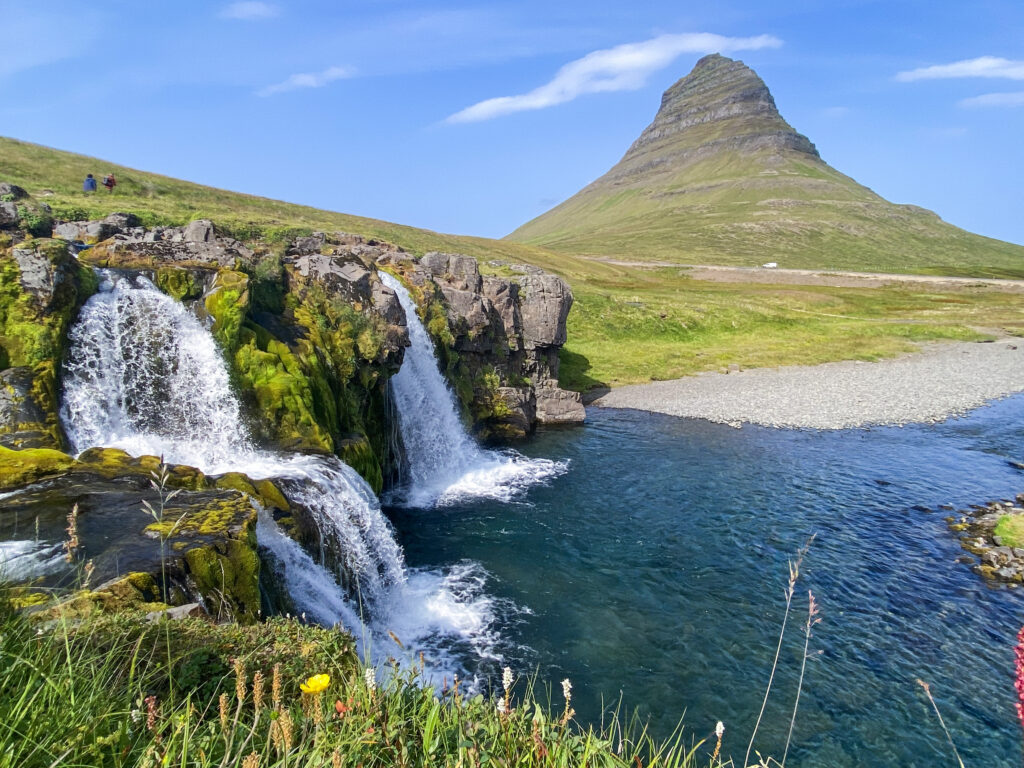
That’s the juice.
There are also unsubstantiated reports that I may have clambered down to the bottom of the waterfall to get the view from below. I will neither confirm nor deny those reports, but will merely include an image as my defense:
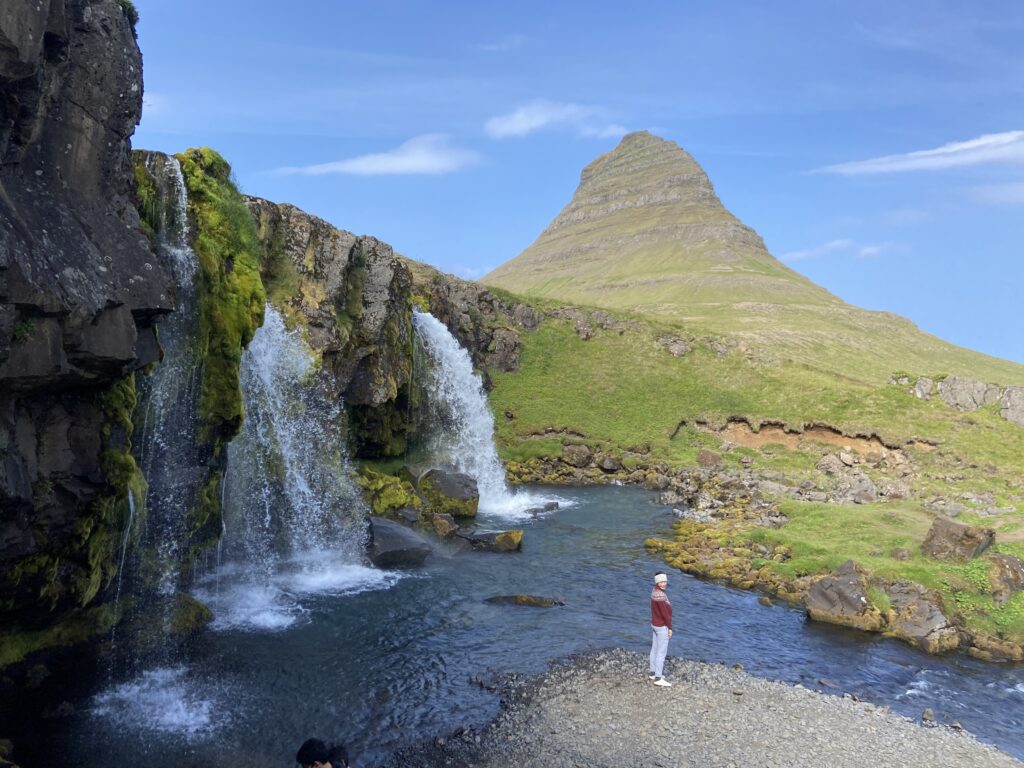
Someone Official showed up and started chastising people basically right after I’d safely moved back to the other side of the rope. Somehow, I got through unscathed, although I didn’t avoid getting chastised by Elizabeth. That was fair; as my newly-official spouse, her job is to chastise me for the dumb things I do.
All in all, Kirkjufell came pretty close to living up to the hype as one of Iceland’s prettiest spots. The crowds were mildly annoying, but I’d 1000% tell anyone visiting Iceland they have to stop there.
Kolgrafarfjördur
Beyond Kirkjufell and the town of Grundarfjörður (one of the largest in the region with almost a full 1,000 people), the Icelandic countryside once again became extremely lonely. There was nobody with us on the road, letting me push our rental car up to 110 km/hr (it’s not as fast as it sounds) with only the fear of hitting a stray sheep. After several minutes, we came around a wide bend and got a beautiful, sweeping view of a fjord. I’m not Scandinavian, so I think this trip was the first time I’d ever seen fjords. This was such a great example of what they look like. We pulled off at a historic marker that mentioned a gigantic and mysterious herring die-off that happened back in 2012 (seriously).
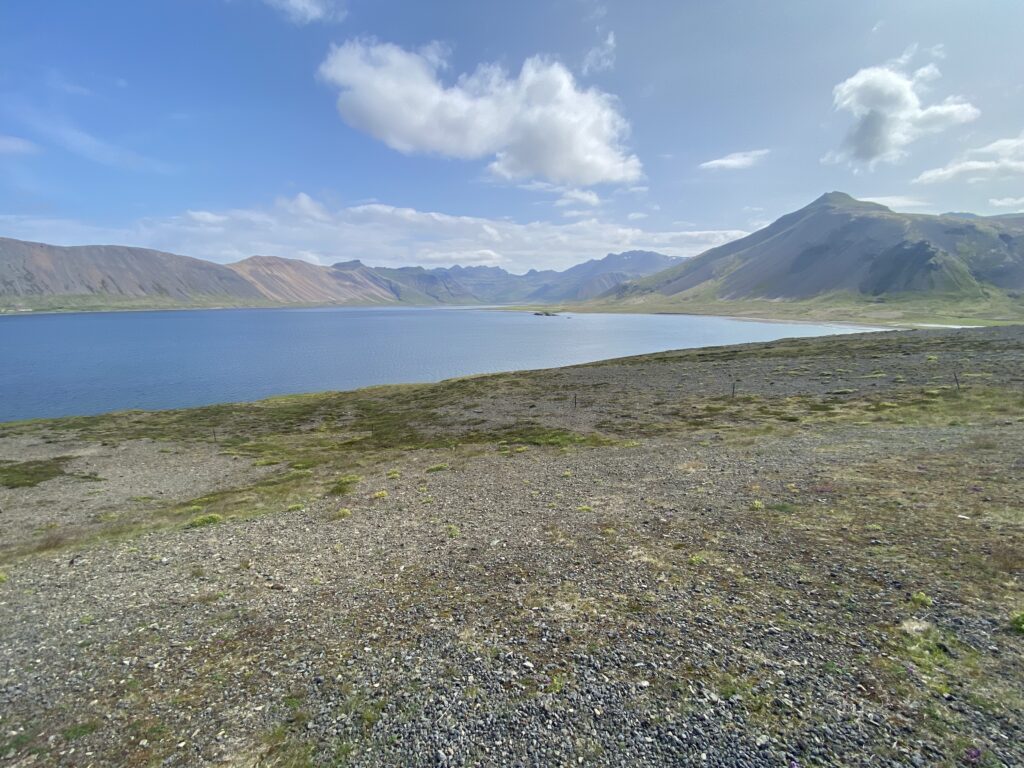
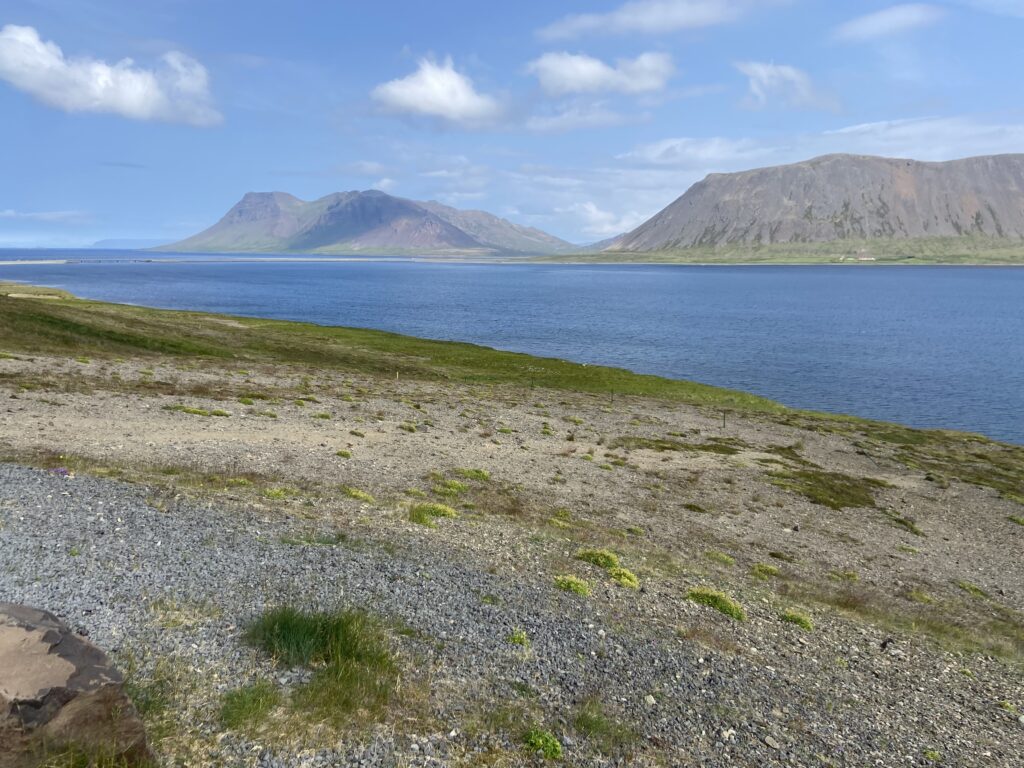
Bjarnarhöfn
I saved the most disgusting for last. Rick Steve mentioned this last location within his book and it just sounded like the quintessential Icelandic tourism opportunity. Whatever you may think Bjarnarhöfn is, I guarantee you’re wrong – it’s a shark museum. And not just any kind of museum – it is a museum to the extremely rare “delicacy” of fermented Icelandic shark. It’s mostly just conducted on someone’s farmstead at the foot one of those nameless Icelandic coastal mountains, which gives it an even more quaint element when you drive up.
After paying that entry fee, guests such as Elizabeth and myself get funneled into a room filled with fishing artifacts from the last several centuries of Iceland. A guide from the museum gives a lecture about the process of making fermented shark every so often. You learn interesting things, such as the fact that Icelandic shark are not illegal to hunt, but they have little-to-no practical value anymore and largely are only caught as a bycatch from commercial fishermen. When they are bycaught, they get purchased by the main producers of fermented Icelandic shark in the region – none other than Bjarnarhöfn. Why is the Icelandic shark nearly useless to humans? Well, we no longer burn shark oil within our lamps, and the meat of Icelandic sharks are extremely poisonous because they have no kidneys. Lovely! Don’t worry, it does in fact get worse – the process of making the shark edible involves burying the meat underground for weeks to let it ferment in its own piss, and then hanging it up in a shed for months to dry. Then they swear that this meat becomes a local delicacy.
The grounds outside where the meat is hanging smell… well… horrible.
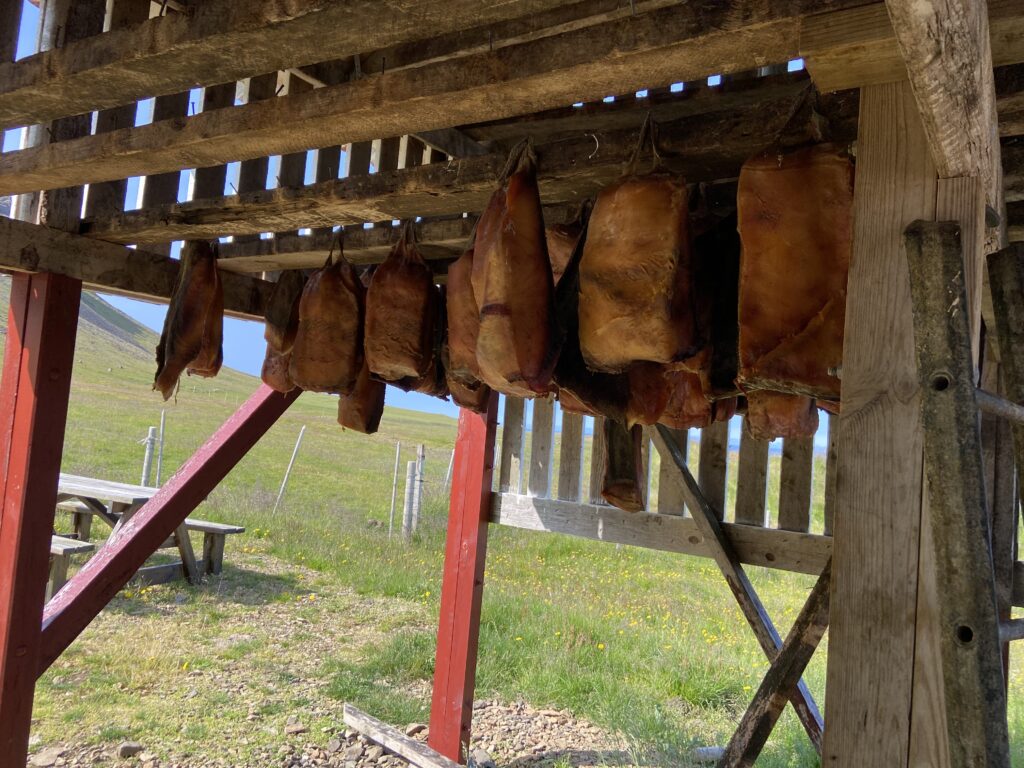
I shuddered just looking at this picture almost a full year later.
Well at least the meat doesn’t taste as bad as it smells, right? Here’s Elizabeth to answer that question:
I assure you her reaction is not an overreaction. It truly is that horrible. Bjarnarhöfn is kind enough to give you a piece of rye bread as a chaser, and it was the only thing that kept me from running into the ocean to wash out my mouth.
All in all, I would definitely recommend Bjarnarhöfn to anyone, but especially to my enemies.
Arnarstapi
About a mile north of our hotel in Hellnar is a little old fishing village called Arnarstapi. This is a popular tourist destination with several hotels and a restaurant due to the presence of some of those famous basalt cliffs. Elizabeth and I got there late in the day on July 26 as we were getting tired and almost ready for bed. It was a nice, picturesque way to end our Snæfellsnes tour with some relaxing oceanside views.
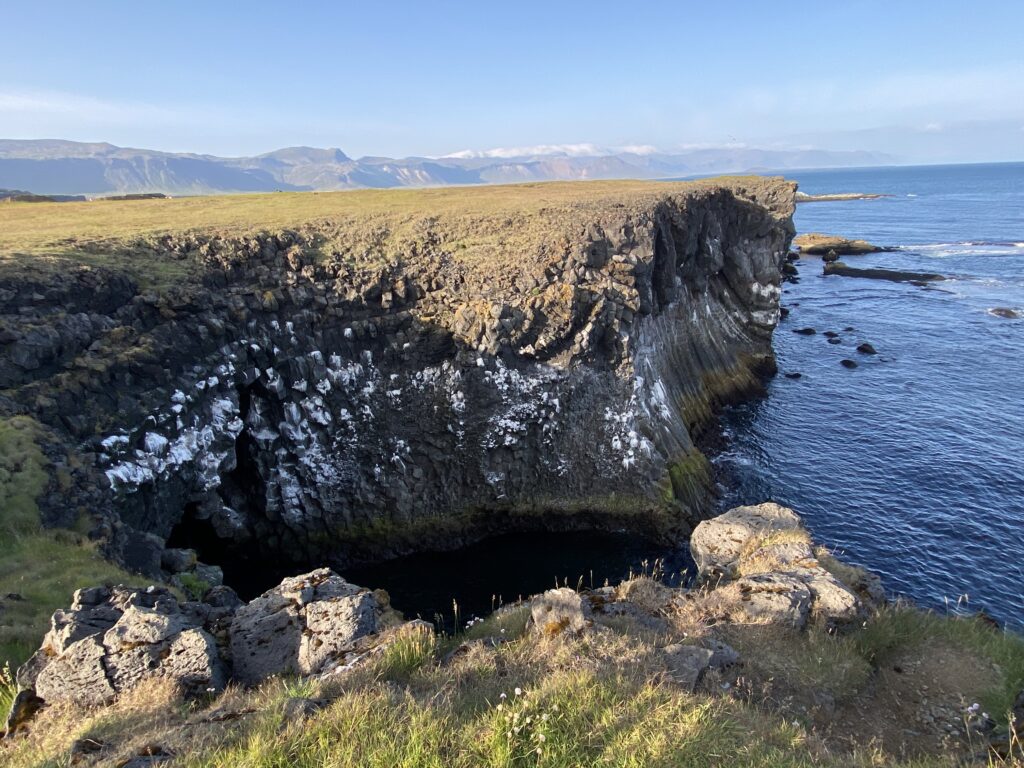
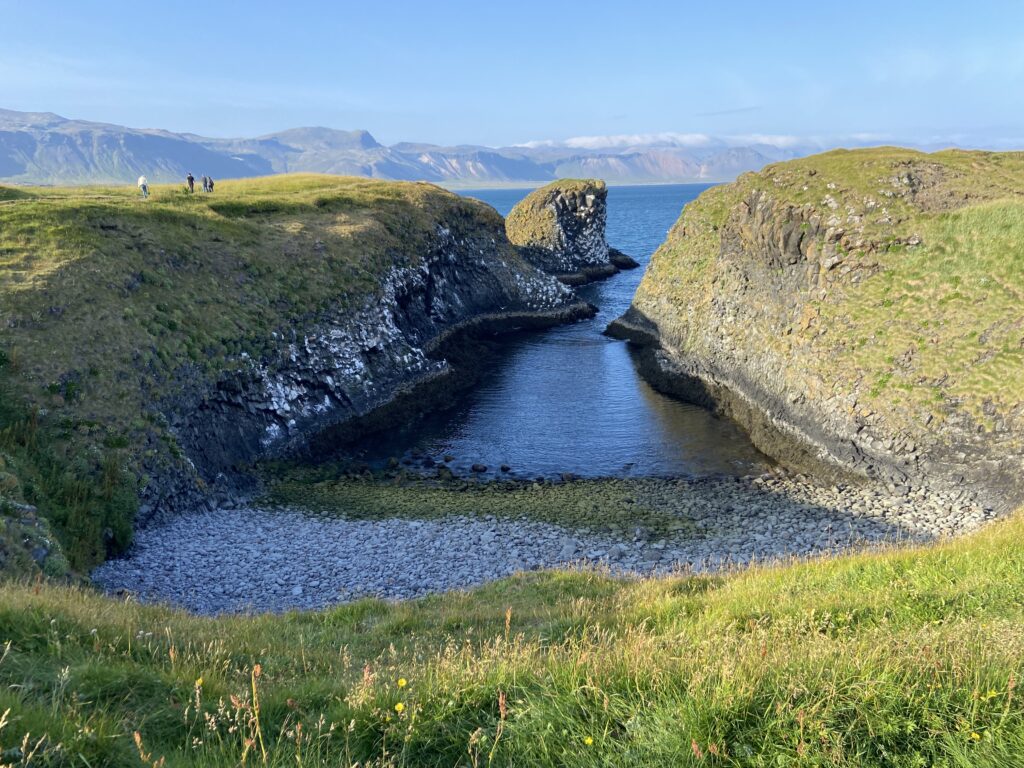
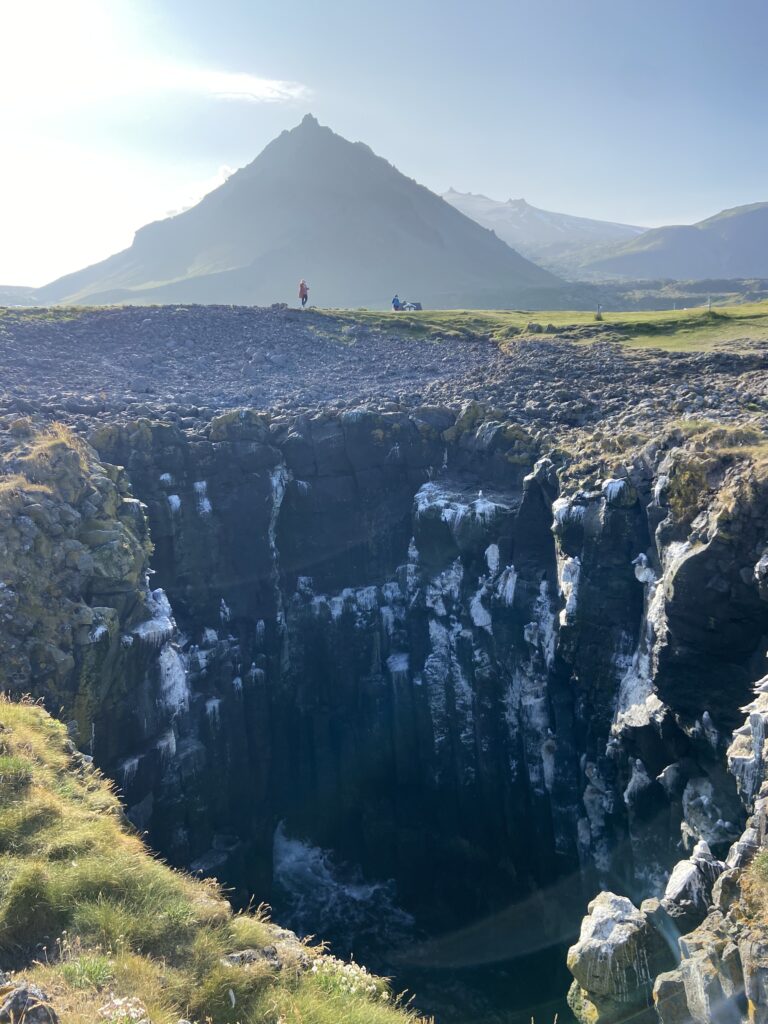
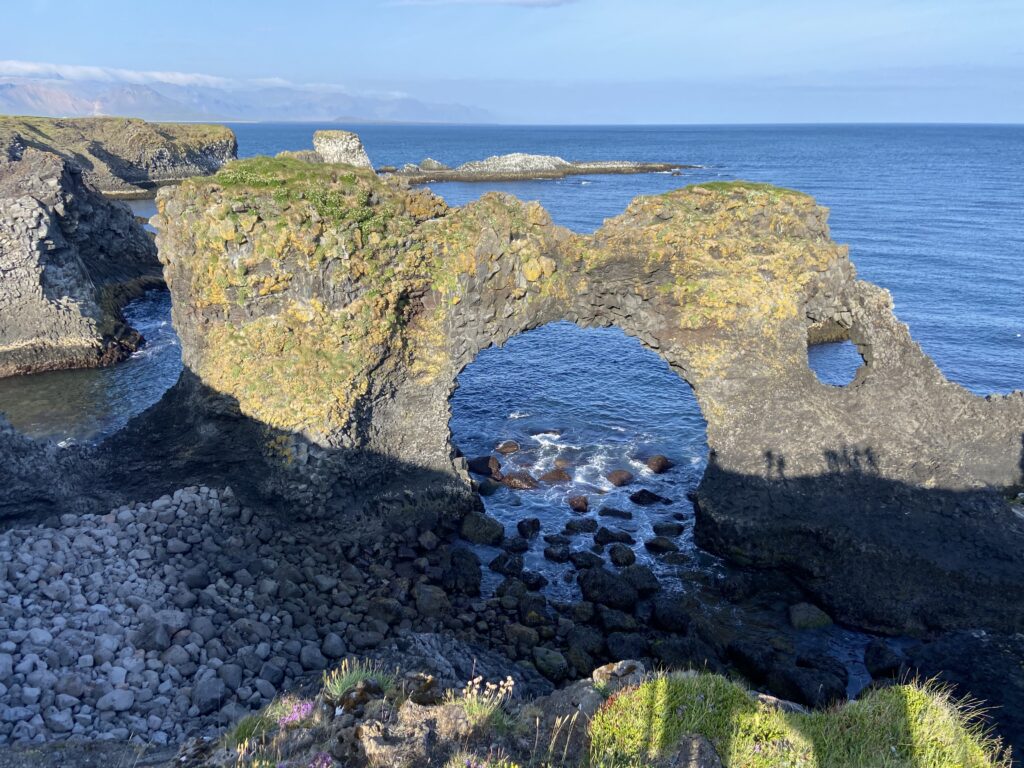
So there you have it. A whole adventure for 48 hours, spanning basically our first 2 days together really in a foreign country. Would I do something like this without a plan again? Absolutely not. Elizabeth is not the type to appreciate spontaneity, which is totally understandable and totally her prerogative. Was it sort of fun this once to climb on top of basalt cliffs, discover yellow-sand beaches, and descend into volcano craters without any knowledge of what was to come? Yes. I found it exhilarating. But I also found it more stressful to do things that way.
In a lot of ways, Snæfellsnes really was a miniature Iceland. We saw so much, ate at a variety of different places, and really got a feel for the vast loneliness that the island packs into it. It was a great way to start our honeymoon, and things would only get more adventurous from there.
